Paul van Yperen's Blog, page 369
September 25, 2015
Malle gevallen (1934)
Every year in early autumn, the Netherlands Film Festival (NFF) takes place. For ten days, the city of Utrecht is the cinema capital of the Netherlands. From 23 September till 2 October, we join the fun with our own Netherlands Film Star Postcards Festival (NFSPF). Today, in our weekly film special the romantic comedy Malle gevallen/Silly situations (Jaap Speyer, 1934), produced by the Dutch mogul Loet C. Barnstijn.
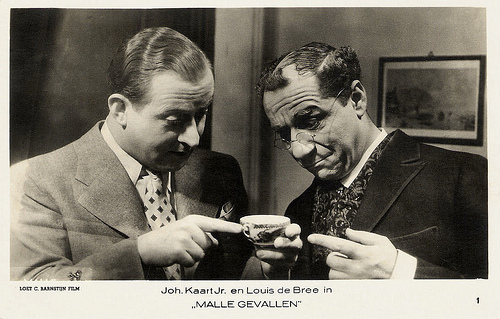
Dutch postcard, no. 1. Photo: Loet C. Barnstijn Film. Publicity still for the Malle gevallen/Silly Situations (1934) with Johan Kaart and Louis de Bree .
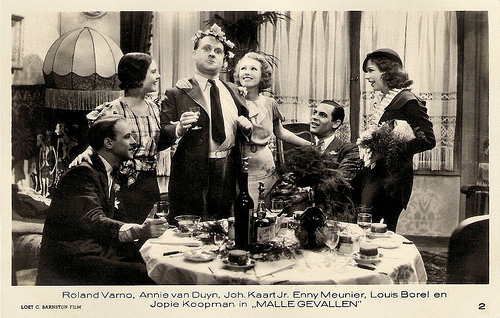
Dutch postcard, no. 2. Photo: Loet C. Barnstijn Film. Publicity still for Malle Gevallen/Silly Situations (1934) with Roland Varno , Annie van Duyn , Johan Kaart , Enny Meunier , Louis Borel , and Jopie Koopman . Collection: Egbert Barten.
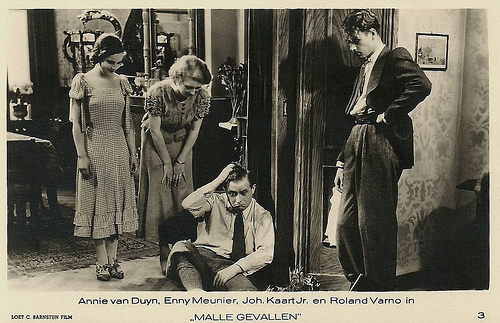
Dutch postcard, no. 3. Photo: Loet C. Barnstijn Film. Publicity still of Annie van Duyn , Enny Meunier , Johan Kaart , and Roland Varno in Malle gevallen (1934).
Three students and three girls
Malle gevallen/Silly situations (1934) was one of the dozens of Dutch sound films, made after the success of the musical De Jantjes/The Tars (Jaap Speyer, 1933). The producer of De Jantjes, film distributor and former cinema operator Loet C. Barnstijn, engaged director Jaap Speyer, who had worked for years in the silent film industry in Berlin and who had directed De Jantjes.
In 1929, Barnstijn had Philips develop the ‘Loetafoon’, his own projection system for sound films. In the few years that followed, he imported sound-film cameras, and was the first person in the Netherlands to produce a short sound film.
Malle gevallen is a romantic comedy written by Hans Martin and Simon Koster based on Martin's 1913 novel. The plot is about three students ( Roland Varno , Louis Borel and Johan Kaart Jr.) who are in love with three girls ( Enny Meunier , Annie van Duyn and Jopie Koopman ).
At the time, Roland Varno (1908-1996) was already known for his role as one of the gymnasiasts in Josef von Sternberg's Der blaue Engel/The Blue Angel (1930). He later worked in Hollywood as a character actor, mainly in B-pictures.
Louis Borel (1905-1973) appeared in films in the Netherlands, in Great Britain and in Hollywood. He also adapted, translated, directed and starred in many stage plays. At the end of his career he became a popular TV star.
Johan Kaart Jr. (1897-1976) starred in seven Dutch films between 1934 and 1937. After the war he played in several other Dutch films. He also worked often for radio and TV, but his main stage was the theatre.
Enny Meunier (1912-1996) was a celebrated stage actress, who also performed on radio and TV. During the 1930s she starred in a few Dutch films.
Stage actress Annie van Duyn (1915-?) played in six films of the 1930s and also in a film after the war. Later she moved to the USA.
Jopie Koopman (1910-1979) was a pretty cabaret artist, who sang and played in several revues and early sound films.
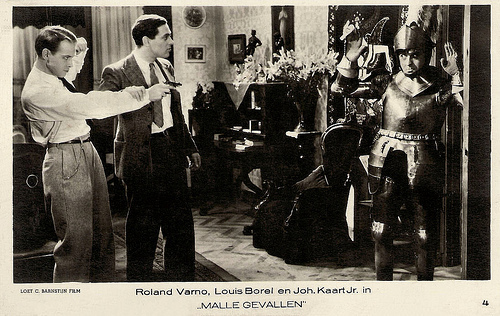
Dutch postcard, no. 4. Photo: Loet C. Barnstijn Film. Publicity still of Roland Varno , Louis Borel , and Johan Kaart in Malle gevallen (1934).
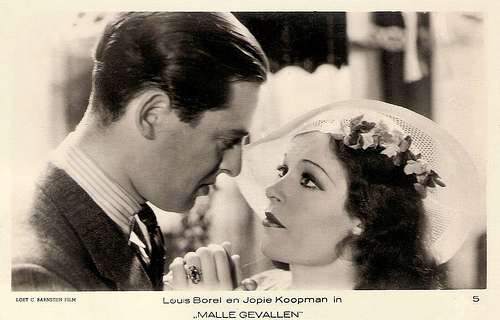
Dutch postcard by M. B.& Z. (M. Bonnist & Zonen, Amsterdam), no. 5. Photo: Loet C. Barnstijn Film. Louis Borel and Jopie Koopman in Malle gevallen (1934).
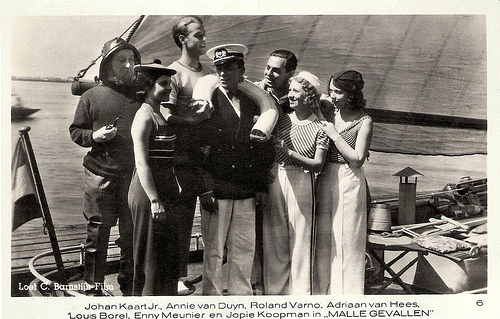
Dutch postcard, no. 6. Photo: Loet C. Barnstijn Film. Publicity still for Malle Gevallen (1934) with Johan Kaart , Annie van Duyn, Roland Varno , Adriaan van Hees, Louis Borel , Enny Meunier and Jopie Koopman . Collection: Egbert Barten.
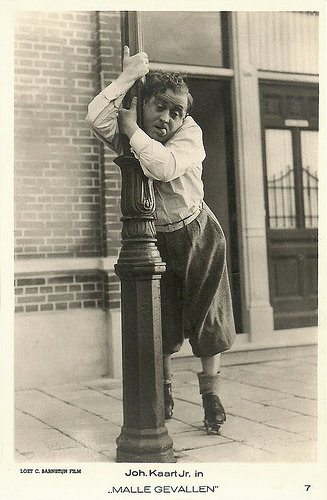
Dutch postcard, no. 7. Photo: Loet C. Barnstijn Film. Publicity still of Johan Kaart Jr. in Malle gevallen (1934).
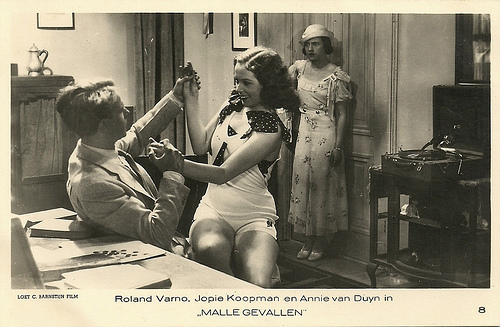
Dutch postcard, no. 8. Photo: Loet C. Barnstijn Film. Roland Varno , Jopie Koopman and Annie van Duyn in Malle gevallen (1934).
Coarseness and bad taste
Malle gevallen/Silly situations (1934) was intended as a light romantic comedy, but it was made into a musical with songs by orchestra leader Max Tak. Although scriptwriters Martin and Koster wanted to make something sophisticated, the final result was a farce. The famous film critic L.J. Jordaan complained about the "coarseness and bad taste" in the film.
Nevertheless, the film was a commercial success. The film was regularly shown in the Dutch cinemas until it was banned in 1942 by the Nazis. Why the Nazis forbade the film is still unknown.
In 1935, Loet C. Barnstijn released De familie van mijn vrouw/The family of my wife (Jaap Speyer, 1935) with Sylvain Poons . That same year he bought the Oosterbeek Estate near Wassenaar and built two film studios. He called this Filmstad (Film City). It consisted of an office, a storage film, a recording studio and a technical workshop.
This studio produced the successful film Merijntje Gijzen's jeugd/Merijntje Gijzen's youth, based on the novels by A.M. de Jong. When World War II broke out, Barnstijn stayed in the United States because of his Jewish background. The film studios of Oosterbeek were confiscated by the German film company Ufa and were later destroyed during an air raid. Barnstijn died in the USA in 1953.
In 2007, the Dutch Filmmuseum presented a DVD of Malle gevallen.
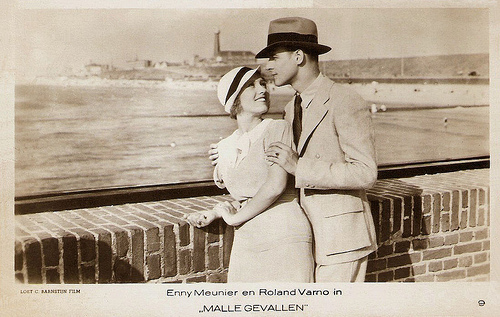
Dutch postcard by M. B.& Z. (M. Bonnist & Zonen, Amsterdam), no. 9. Photo: Loet C. Barnstijn Film. Roland Varno and Enny Meunier in Malle gevallen (1934).
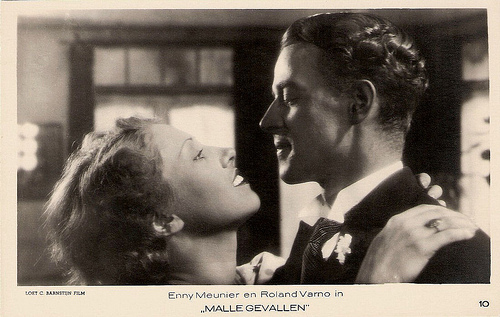
Dutch postcard by M. B.& Z. (M. Bonnist & Zonen, Amsterdam), no. 10. Photo: Loet C. Barnstijn Film. Roland Varno and Enny Meunier in Malle gevallen (1934).
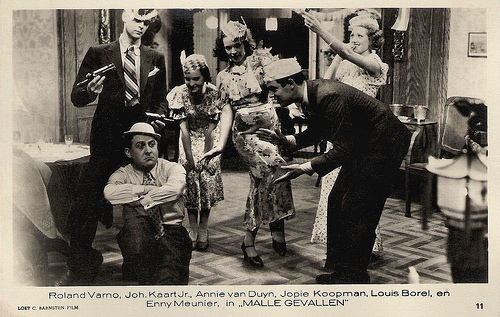
Dutch postcard, no. 11. Photo: Loet C. Barnstijn Film. Publicity still for Malle Gevallen (1934) with Roland Varno , Johan Kaart , Annie van Duyn , Louis Borel, Jopie Koopman and Enny Meunier . Collection: Egbert Barten.
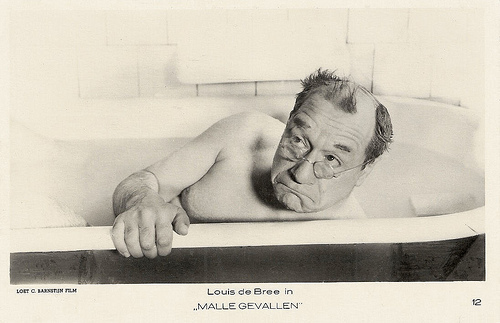
Dutch postcard, no. 12. Photo: Loet C. Barnstijn Film. Publicity still for Malle Gevallen (1934) with Louis de Bree .
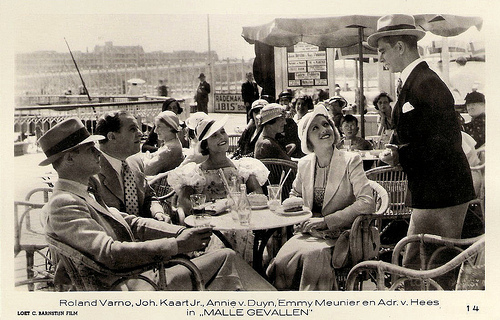
Dutch postcard, no. 14. Photo: Loet C. Barnstijn Film. Publicity still for Malle Gevallen (1934) with Roland Varno , Johan Kaart, Annie van Duyn , Enny Meunier and Adriaan van Hees. Collection: Egbert Barten.
Sources: Eye (Dutch), Wikipedia and IMDb.

Dutch postcard, no. 1. Photo: Loet C. Barnstijn Film. Publicity still for the Malle gevallen/Silly Situations (1934) with Johan Kaart and Louis de Bree .

Dutch postcard, no. 2. Photo: Loet C. Barnstijn Film. Publicity still for Malle Gevallen/Silly Situations (1934) with Roland Varno , Annie van Duyn , Johan Kaart , Enny Meunier , Louis Borel , and Jopie Koopman . Collection: Egbert Barten.

Dutch postcard, no. 3. Photo: Loet C. Barnstijn Film. Publicity still of Annie van Duyn , Enny Meunier , Johan Kaart , and Roland Varno in Malle gevallen (1934).
Three students and three girls
Malle gevallen/Silly situations (1934) was one of the dozens of Dutch sound films, made after the success of the musical De Jantjes/The Tars (Jaap Speyer, 1933). The producer of De Jantjes, film distributor and former cinema operator Loet C. Barnstijn, engaged director Jaap Speyer, who had worked for years in the silent film industry in Berlin and who had directed De Jantjes.
In 1929, Barnstijn had Philips develop the ‘Loetafoon’, his own projection system for sound films. In the few years that followed, he imported sound-film cameras, and was the first person in the Netherlands to produce a short sound film.
Malle gevallen is a romantic comedy written by Hans Martin and Simon Koster based on Martin's 1913 novel. The plot is about three students ( Roland Varno , Louis Borel and Johan Kaart Jr.) who are in love with three girls ( Enny Meunier , Annie van Duyn and Jopie Koopman ).
At the time, Roland Varno (1908-1996) was already known for his role as one of the gymnasiasts in Josef von Sternberg's Der blaue Engel/The Blue Angel (1930). He later worked in Hollywood as a character actor, mainly in B-pictures.
Louis Borel (1905-1973) appeared in films in the Netherlands, in Great Britain and in Hollywood. He also adapted, translated, directed and starred in many stage plays. At the end of his career he became a popular TV star.
Johan Kaart Jr. (1897-1976) starred in seven Dutch films between 1934 and 1937. After the war he played in several other Dutch films. He also worked often for radio and TV, but his main stage was the theatre.
Enny Meunier (1912-1996) was a celebrated stage actress, who also performed on radio and TV. During the 1930s she starred in a few Dutch films.
Stage actress Annie van Duyn (1915-?) played in six films of the 1930s and also in a film after the war. Later she moved to the USA.
Jopie Koopman (1910-1979) was a pretty cabaret artist, who sang and played in several revues and early sound films.

Dutch postcard, no. 4. Photo: Loet C. Barnstijn Film. Publicity still of Roland Varno , Louis Borel , and Johan Kaart in Malle gevallen (1934).

Dutch postcard by M. B.& Z. (M. Bonnist & Zonen, Amsterdam), no. 5. Photo: Loet C. Barnstijn Film. Louis Borel and Jopie Koopman in Malle gevallen (1934).

Dutch postcard, no. 6. Photo: Loet C. Barnstijn Film. Publicity still for Malle Gevallen (1934) with Johan Kaart , Annie van Duyn, Roland Varno , Adriaan van Hees, Louis Borel , Enny Meunier and Jopie Koopman . Collection: Egbert Barten.

Dutch postcard, no. 7. Photo: Loet C. Barnstijn Film. Publicity still of Johan Kaart Jr. in Malle gevallen (1934).

Dutch postcard, no. 8. Photo: Loet C. Barnstijn Film. Roland Varno , Jopie Koopman and Annie van Duyn in Malle gevallen (1934).
Coarseness and bad taste
Malle gevallen/Silly situations (1934) was intended as a light romantic comedy, but it was made into a musical with songs by orchestra leader Max Tak. Although scriptwriters Martin and Koster wanted to make something sophisticated, the final result was a farce. The famous film critic L.J. Jordaan complained about the "coarseness and bad taste" in the film.
Nevertheless, the film was a commercial success. The film was regularly shown in the Dutch cinemas until it was banned in 1942 by the Nazis. Why the Nazis forbade the film is still unknown.
In 1935, Loet C. Barnstijn released De familie van mijn vrouw/The family of my wife (Jaap Speyer, 1935) with Sylvain Poons . That same year he bought the Oosterbeek Estate near Wassenaar and built two film studios. He called this Filmstad (Film City). It consisted of an office, a storage film, a recording studio and a technical workshop.
This studio produced the successful film Merijntje Gijzen's jeugd/Merijntje Gijzen's youth, based on the novels by A.M. de Jong. When World War II broke out, Barnstijn stayed in the United States because of his Jewish background. The film studios of Oosterbeek were confiscated by the German film company Ufa and were later destroyed during an air raid. Barnstijn died in the USA in 1953.
In 2007, the Dutch Filmmuseum presented a DVD of Malle gevallen.

Dutch postcard by M. B.& Z. (M. Bonnist & Zonen, Amsterdam), no. 9. Photo: Loet C. Barnstijn Film. Roland Varno and Enny Meunier in Malle gevallen (1934).

Dutch postcard by M. B.& Z. (M. Bonnist & Zonen, Amsterdam), no. 10. Photo: Loet C. Barnstijn Film. Roland Varno and Enny Meunier in Malle gevallen (1934).

Dutch postcard, no. 11. Photo: Loet C. Barnstijn Film. Publicity still for Malle Gevallen (1934) with Roland Varno , Johan Kaart , Annie van Duyn , Louis Borel, Jopie Koopman and Enny Meunier . Collection: Egbert Barten.

Dutch postcard, no. 12. Photo: Loet C. Barnstijn Film. Publicity still for Malle Gevallen (1934) with Louis de Bree .

Dutch postcard, no. 14. Photo: Loet C. Barnstijn Film. Publicity still for Malle Gevallen (1934) with Roland Varno , Johan Kaart, Annie van Duyn , Enny Meunier and Adriaan van Hees. Collection: Egbert Barten.
Sources: Eye (Dutch), Wikipedia and IMDb.
Published on September 25, 2015 22:00
September 24, 2015
Yoka Berretty
Every year in early autumn, the Netherlands Film Festival (NFF) takes place. For ten days, the city of Utrecht is the cinema capital of the Netherlands. From 23 September till 2 October, we join the fun with our own Netherlands Film Star Postcards Festival (NFSPF). Today, a post on singer and actress Yoka Berretty (1928), who started her career as a glamorous starlet in Italian films.
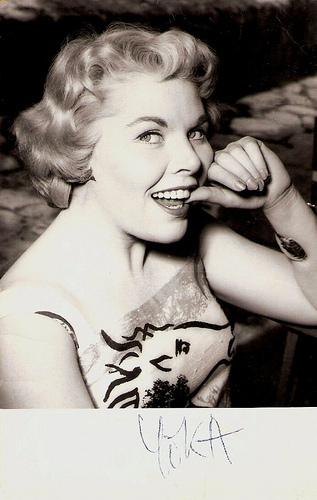
Postcard by Forronia.
Italian films
Yoka Berretty was born as Johanna Ernistina Petrusa Meijeringh in Rotterdam, The Netherlands, in 1928.
After secondary school, she attended acting classes at the Actor's Studio in New York, at the Théatre de Poche with Marcel Marceau and Etienne Decroux in Paris, and in Rome.
Yoka started her career with bit and supporting parts in the Italian films Angela (Edoardo Anton, Dennis O’Keefe, 1955) featuring Mara Lane , the hit Pane, amore e.../Scandal in Sorrento (Dino Risi, 1955) starring Vittorio de Sica and Sophia Loren , the hilarious farce La banda degli onesti/The Band of Honest Men (Camillo Mastrocinque, 1956) starring the comedians Totò and Peppino De Filippo , and the drama Gli occhi senza luce/The Eyes Without Light (Flavio Calzavara, 1956) with Milly Vitale .
She returned to The Netherlands, where she worked on stage for theatre companies like Nederlandse Comedie, Ensemble, Centrum, Amsterdams Volkstoneel and Theaterunie. She also appeared
on radio and television.
Incidentally, Berretty played small roles in international film productions such as the war drama The Last Blitzkrieg (Arthur Dreifuss, 1959) starring Van Johnson and the Knut Hamsun adaptation Das Letzte Kapitel/The Last Chapter (Wolfgang Liebeneiner, 1961) with Hansjörg Felmy .
Vittorio de Sica and Sophia Loren dance the mambo in Pane, amore e.../Scandal in Sorrento (1955). Source: Vincent Kent (YouTube). Yoka Berretty plays Erica.
Yoka sings Een op de valreep (one for the road) in 1960. Recognize the picture? Source: Disco82 (YouTube).
TV Personality
Yoka Berretty became a well known TV personality in The Netherlands. In 1959, she was the organizer and co-presenter of the first TV benefit action show Redt een Kind/Save A Child for child refugees from Algeria. A national sensation was the satiric TV show Zo is het toevallig ook nog eens een keer (1963-1966), based on the BBC programme That Was the Week That Was.
She also played parts in the prestigious Dutch films Makkers staakt uw wild geraas/That Joyous Eve (Fons Rademakers, 1960) as the wife of Guus Oster, and opposite Rob de Vries in De Overval/The Silent Raid (Paul Rotha, 1962) about the Dutch resistance in the Second World War.
Her later films were VD (Wim Verstappen, 1972) with Kees Brusse, Rufus (Samuel Meyering, 1975) starring Rijk de Gooyer, the German-Dutch coproduction Charlotte (Frans Weisz, 1981) starring Birgit Doll and Derek Jacobi, the thriller De Prooi/The Prey (Vivian Pieters, 1985) and Advocaat van de Hanen/Punk Lawyer (Gerrit van Elst, 1996) with Pierre Bokma.
In the 1990s, Berretty played leading parts in three films by director and publicist Theo van Gogh, who was assasinated in 2004: Eva (1992), Au!/Ouch! (1997) and In het belang van de staat/In the Interests of the State (1997) starring Marlies Heuer.
The last times she appeared for the cameras was on television in the popular crime series Baantjer (2000), and in the short film Anderland (2003).
Yoka Berretty was married twice. Her first marriage was with Dominique Berretty, a famed Magnum-photographer whose surname she adopted. Later she was married to publisher Andreas Landshoff, the son of German film actress Ruth Hellberg . Yoka Berretty is the mother of Yolante Berretty, and of director Benjamin Landshoff, in whose TV series Erwassus/Once upon a time (1997), she appeared.
De Overval/The Silent Raid (Paul Rotha, 1962). Full movie, no subtitles. Source: kitekat112 (YouTube).
Yoka Berretty sings the title song of the satiric TV programme Zo is het toevallig ook nog eens een keer (1963-1966). Source: Toenwaskwaliteit nogheelgewoon (YouTube).
This is a post for Postcard Friendship Friday, hosted by Beth at the blog The Best Hearts are Crunchy. You can visit her by clicking on the button below.

Source: Beeld en Geluid Wiki (Dutch), Wikipedia (Dutch), Trouw (Dutch) and .

Postcard by Forronia.
Italian films
Yoka Berretty was born as Johanna Ernistina Petrusa Meijeringh in Rotterdam, The Netherlands, in 1928.
After secondary school, she attended acting classes at the Actor's Studio in New York, at the Théatre de Poche with Marcel Marceau and Etienne Decroux in Paris, and in Rome.
Yoka started her career with bit and supporting parts in the Italian films Angela (Edoardo Anton, Dennis O’Keefe, 1955) featuring Mara Lane , the hit Pane, amore e.../Scandal in Sorrento (Dino Risi, 1955) starring Vittorio de Sica and Sophia Loren , the hilarious farce La banda degli onesti/The Band of Honest Men (Camillo Mastrocinque, 1956) starring the comedians Totò and Peppino De Filippo , and the drama Gli occhi senza luce/The Eyes Without Light (Flavio Calzavara, 1956) with Milly Vitale .
She returned to The Netherlands, where she worked on stage for theatre companies like Nederlandse Comedie, Ensemble, Centrum, Amsterdams Volkstoneel and Theaterunie. She also appeared
on radio and television.
Incidentally, Berretty played small roles in international film productions such as the war drama The Last Blitzkrieg (Arthur Dreifuss, 1959) starring Van Johnson and the Knut Hamsun adaptation Das Letzte Kapitel/The Last Chapter (Wolfgang Liebeneiner, 1961) with Hansjörg Felmy .
Vittorio de Sica and Sophia Loren dance the mambo in Pane, amore e.../Scandal in Sorrento (1955). Source: Vincent Kent (YouTube). Yoka Berretty plays Erica.
Yoka sings Een op de valreep (one for the road) in 1960. Recognize the picture? Source: Disco82 (YouTube).
TV Personality
Yoka Berretty became a well known TV personality in The Netherlands. In 1959, she was the organizer and co-presenter of the first TV benefit action show Redt een Kind/Save A Child for child refugees from Algeria. A national sensation was the satiric TV show Zo is het toevallig ook nog eens een keer (1963-1966), based on the BBC programme That Was the Week That Was.
She also played parts in the prestigious Dutch films Makkers staakt uw wild geraas/That Joyous Eve (Fons Rademakers, 1960) as the wife of Guus Oster, and opposite Rob de Vries in De Overval/The Silent Raid (Paul Rotha, 1962) about the Dutch resistance in the Second World War.
Her later films were VD (Wim Verstappen, 1972) with Kees Brusse, Rufus (Samuel Meyering, 1975) starring Rijk de Gooyer, the German-Dutch coproduction Charlotte (Frans Weisz, 1981) starring Birgit Doll and Derek Jacobi, the thriller De Prooi/The Prey (Vivian Pieters, 1985) and Advocaat van de Hanen/Punk Lawyer (Gerrit van Elst, 1996) with Pierre Bokma.
In the 1990s, Berretty played leading parts in three films by director and publicist Theo van Gogh, who was assasinated in 2004: Eva (1992), Au!/Ouch! (1997) and In het belang van de staat/In the Interests of the State (1997) starring Marlies Heuer.
The last times she appeared for the cameras was on television in the popular crime series Baantjer (2000), and in the short film Anderland (2003).
Yoka Berretty was married twice. Her first marriage was with Dominique Berretty, a famed Magnum-photographer whose surname she adopted. Later she was married to publisher Andreas Landshoff, the son of German film actress Ruth Hellberg . Yoka Berretty is the mother of Yolante Berretty, and of director Benjamin Landshoff, in whose TV series Erwassus/Once upon a time (1997), she appeared.
De Overval/The Silent Raid (Paul Rotha, 1962). Full movie, no subtitles. Source: kitekat112 (YouTube).
Yoka Berretty sings the title song of the satiric TV programme Zo is het toevallig ook nog eens een keer (1963-1966). Source: Toenwaskwaliteit nogheelgewoon (YouTube).
This is a post for Postcard Friendship Friday, hosted by Beth at the blog The Best Hearts are Crunchy. You can visit her by clicking on the button below.

Source: Beeld en Geluid Wiki (Dutch), Wikipedia (Dutch), Trouw (Dutch) and .
Published on September 24, 2015 22:00
September 23, 2015
Floris (1969)
Every year in early autumn, the Netherlands Film Festival (NFF) takes place. For ten days, the city of Utrecht is the cinema capital of the Netherlands. From 23 September till 2 October, we join the fun with our own Netherlands Film Star Postcards Festival (NFSPF). Today, a post on a Dutch television series, which started three of the most successful careers in the history of the Dutch cinema. It's our all-time favourite TV series - Floris (1969), directed by Paul Verhoeven, written by Gerard Soeteman and starring the young Rutger Hauer.
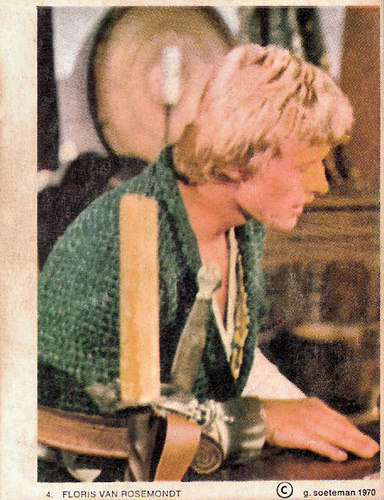
Dutch collectors card, no. 4, 1970. Photo: Gerard Soeteman. Publicity still for the TV series Floris (Paul Verhoeven, 1969). Rutger Hauer as Floris van Rosemondt.
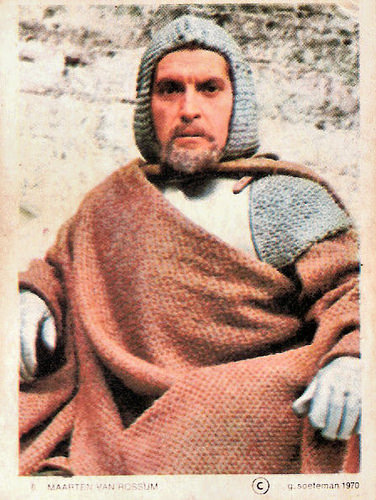
Dutch collectors card, no. 5 (?), 1970. Photo: Gerard Soeteman. Publicity still for the TV series Floris (Paul Verhoeven, 1969). Hans Culeman as Maarten van Rossum.

Dutch collectors card, no. 7, 1970. Photo: Gerard Soeteman. Publicity still for the TV series Floris (Paul Verhoeven, 1969). Hans Boskamp as Lange Pier.
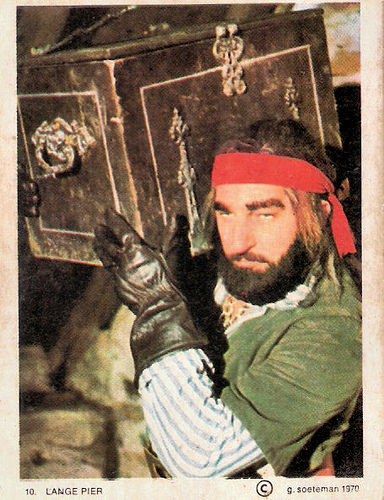
Dutch collectors card, no. 10, 1970. Photo: Gerard Soeteman. Publicity still for the TV series Floris (Paul Verhoeven, 1969). Hans Boskamp as Lange Pier.

Dutch collectors card, no. 14, 1970. Photo: Gerard Soeteman. Publicity still for the TV series Floris (Paul Verhoeven, 1969).
Unforgettable screen debut
Yeah! Finally, I was able to lay my hands on some vintage collectors cards of Floris (1969). These small cards, produced in 1970, are quite rare these days, and therefor my series is not complete yet.
The Dutch television series, set in the Middle Ages, is the favourite series for many of my generation in the Netherlands and also in Belgium. At the time, all kinds of merchandise was produced for the kids and of course they are a cult now.
In the series, blonde, athletic and the then incredibly young Rutger Hauer made his screen debut as the exiled knight Floris van Rosemondt. His performance is unforgettable, Hauer is the ultimate knight.
With his Indian friend Sindala (Jos Bergman), Floris tries to get his birth right papers back from Maarten van Rossem (Hans Culeman), an evil lord.
During their quest they get help from Wolter van Oldenstein (Ton Vos), a noble man who offers them a place in his castle. They also meet the imposing pirate Lange Pier (Hans Boskamp).
Apart from Sindala and Floris, all the characters are based on historical figures. Scriptwriter Gerard Soeteman did an amazingly inventive job and it is one of the reasons why many adults love to see this childrens series too.
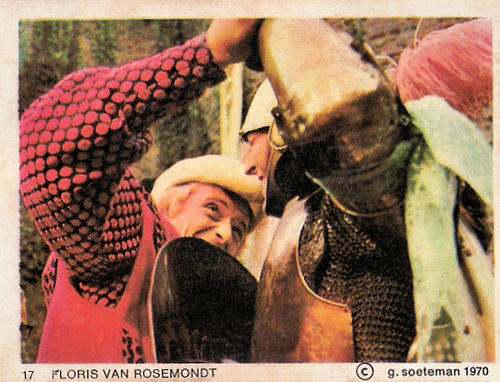
Dutch collectors card, no. 17, 1970. Photo: Gerard Soeteman. Publicity still for the TV series Floris (Paul Verhoeven, 1969).
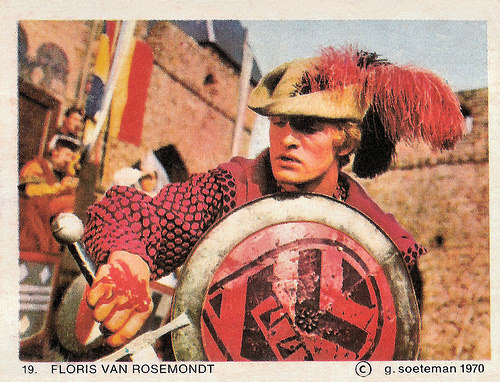
Dutch collectors card, no. 19, 1970. Photo: Gerard Soeteman. Publicity still for the TV series Floris (Paul Verhoeven, 1969).
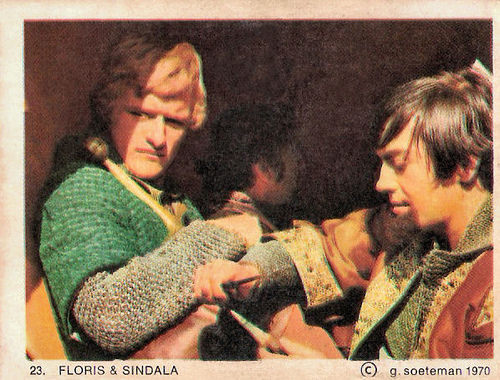
Dutch collectors card, no. 23, 1970. Photo: Gerard Soeteman. Publicity still for the TV series Floris (Paul Verhoeven, 1969).
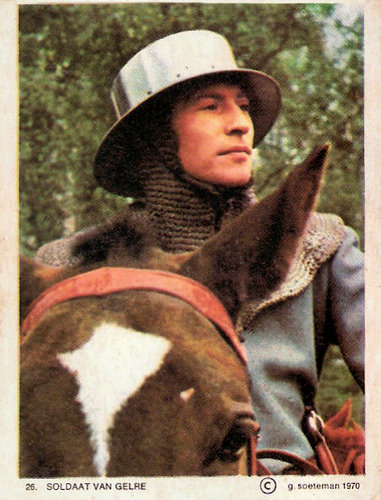
Dutch collectors card, no. 26, 1970. Photo: Gerard Soeteman. Publicity still for the TV series Floris (Paul Verhoeven, 1969). Caption: Soldaat van Gelre (Soldier Van Gelre).
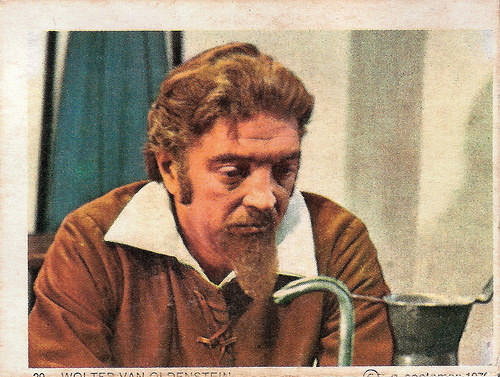
Dutch collectors card, no. 29 (?), 1970. Photo: Gerard Soeteman. Publicity still for the TV series Floris (Paul Verhoeven, 1969). Ton Vos als Wolter van Oldenstein.
In the best Robin Hood style
In 1967, the success of television series like the British Ivanhoe (1958-1959) with Roger Moore , the French Thierry La Fronde/Thierry the Sling (1963-1966) with Jean-Claude Drouot , and the Flemish Johan en de Alverman (1965) with Frank Aendenboom inspired Carel Enkelaar, manager of NTS Television to make a similar series, set in the Netherlands.
Hanne Aboe Derwort highly recommends the series at IMDb : "One of the first Middle Age series ever, the stories of the adventures of Floris in medieval Holland are also among the most funny tv-series ever.
The budget was very low, which can be seen, but the interaction between the actors is nothing less but wonderful. Floris and his trusty companion Sindala is in best Robin Hood style, but with the addition of Eastern magic to the swordfighting skills and sheer strength (and luck) of our hero. (...)
The fact that the series is in b/w actually helps, no need to mess around with anything when somebody's wounded. If you can locate the tapes, watch it."

Dutch collectors card, no. 30, 1970. Photo: Gerard Soeteman. Publicity still for the TV series Floris (Paul Verhoeven, 1969).
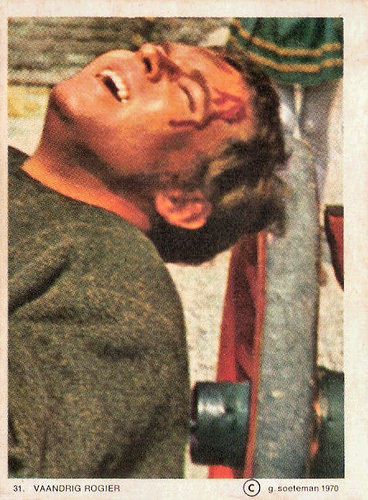
Dutch collectors card, no. 31, 1970. Photo: Gerard Soeteman. Publicity still for the TV series Floris (Paul Verhoeven, 1969). Caption: Vaandrig Rogier (Ensign-bearer Rogier). Rogier was played by Jacco van Renesse.
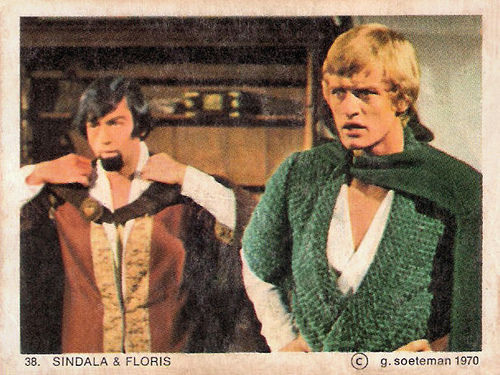
Dutch collectors card, no. 38, 1970. Photo: Gerard Soeteman. Publicity still for the TV series Floris (Paul Verhoeven, 1969).
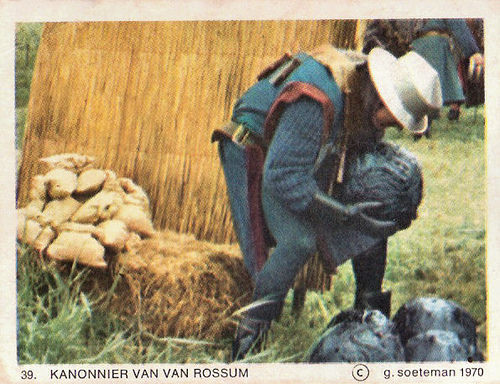
Dutch collectors card, no. 39, 1970. Photo: Gerard Soeteman. Publicity still for the TV series Floris (Paul Verhoeven, 1969). Caption: Kanonnier van Van Rossum (Gunner of Van Rossum).
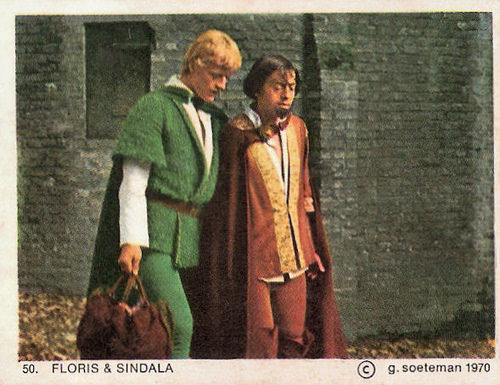
Dutch collectors card, no. 50, 1970. Photo: Gerard Soeteman. Publicity still for the TV series Floris (Paul Verhoeven, 1969).
The most popular TV series in the Netherlands
In 1969, Floris was the most popular TV series in the Netherlands. The series had many reruns through the years.
Floris has also been shown in East Germany (as Floris - Der Mann mit dem Schwert) and Scotland dubbed in English. In the UK, the series aired on Yorkshire Television in 1970 as The Adventures of Floris. None of the English dubbed episodes survive.
1975 saw a German remake of the series, Floris von Rosenmund (Ferry Radax, 1975), again starring Rutger Hauer , but with German actor Derval de Faria as Sindala. This version put much more emphasis on the comedic aspects of the stories.
The series also lead to the film Floris (Jean van de Velde, 2004) which features Michiel Huisman (known for his role in Game of Thrones) as the grandson of the original Floris. Some of the footage from the 1969 series with Hauer and Bergman is included. Rutger Hauer was originally asked to play the father of young Floris, but he declined.
It would be great if Verhoeven, Soeteman and Hauer could reunite for one more film. Even after more than 40 years, it's not too late. Both Verhoeven and Hauer are still very active. Please, mr Soeteman write that one script which they simply can't refuse.
Episode Het brandende water (The burning water). Sorry, no subtitles. Source: eikcid (YouTube).
Dutch TV documentary in the series Andere tijden (Other times). Sorry, no subtitles. Source: 192TVideo (YouTube).
Source: Hanne Aboe Derwort (IMDb), Wikipedia and IMDb.

Dutch collectors card, no. 4, 1970. Photo: Gerard Soeteman. Publicity still for the TV series Floris (Paul Verhoeven, 1969). Rutger Hauer as Floris van Rosemondt.

Dutch collectors card, no. 5 (?), 1970. Photo: Gerard Soeteman. Publicity still for the TV series Floris (Paul Verhoeven, 1969). Hans Culeman as Maarten van Rossum.

Dutch collectors card, no. 7, 1970. Photo: Gerard Soeteman. Publicity still for the TV series Floris (Paul Verhoeven, 1969). Hans Boskamp as Lange Pier.

Dutch collectors card, no. 10, 1970. Photo: Gerard Soeteman. Publicity still for the TV series Floris (Paul Verhoeven, 1969). Hans Boskamp as Lange Pier.

Dutch collectors card, no. 14, 1970. Photo: Gerard Soeteman. Publicity still for the TV series Floris (Paul Verhoeven, 1969).
Unforgettable screen debut
Yeah! Finally, I was able to lay my hands on some vintage collectors cards of Floris (1969). These small cards, produced in 1970, are quite rare these days, and therefor my series is not complete yet.
The Dutch television series, set in the Middle Ages, is the favourite series for many of my generation in the Netherlands and also in Belgium. At the time, all kinds of merchandise was produced for the kids and of course they are a cult now.
In the series, blonde, athletic and the then incredibly young Rutger Hauer made his screen debut as the exiled knight Floris van Rosemondt. His performance is unforgettable, Hauer is the ultimate knight.
With his Indian friend Sindala (Jos Bergman), Floris tries to get his birth right papers back from Maarten van Rossem (Hans Culeman), an evil lord.
During their quest they get help from Wolter van Oldenstein (Ton Vos), a noble man who offers them a place in his castle. They also meet the imposing pirate Lange Pier (Hans Boskamp).
Apart from Sindala and Floris, all the characters are based on historical figures. Scriptwriter Gerard Soeteman did an amazingly inventive job and it is one of the reasons why many adults love to see this childrens series too.

Dutch collectors card, no. 17, 1970. Photo: Gerard Soeteman. Publicity still for the TV series Floris (Paul Verhoeven, 1969).

Dutch collectors card, no. 19, 1970. Photo: Gerard Soeteman. Publicity still for the TV series Floris (Paul Verhoeven, 1969).

Dutch collectors card, no. 23, 1970. Photo: Gerard Soeteman. Publicity still for the TV series Floris (Paul Verhoeven, 1969).

Dutch collectors card, no. 26, 1970. Photo: Gerard Soeteman. Publicity still for the TV series Floris (Paul Verhoeven, 1969). Caption: Soldaat van Gelre (Soldier Van Gelre).

Dutch collectors card, no. 29 (?), 1970. Photo: Gerard Soeteman. Publicity still for the TV series Floris (Paul Verhoeven, 1969). Ton Vos als Wolter van Oldenstein.
In the best Robin Hood style
In 1967, the success of television series like the British Ivanhoe (1958-1959) with Roger Moore , the French Thierry La Fronde/Thierry the Sling (1963-1966) with Jean-Claude Drouot , and the Flemish Johan en de Alverman (1965) with Frank Aendenboom inspired Carel Enkelaar, manager of NTS Television to make a similar series, set in the Netherlands.
Hanne Aboe Derwort highly recommends the series at IMDb : "One of the first Middle Age series ever, the stories of the adventures of Floris in medieval Holland are also among the most funny tv-series ever.
The budget was very low, which can be seen, but the interaction between the actors is nothing less but wonderful. Floris and his trusty companion Sindala is in best Robin Hood style, but with the addition of Eastern magic to the swordfighting skills and sheer strength (and luck) of our hero. (...)
The fact that the series is in b/w actually helps, no need to mess around with anything when somebody's wounded. If you can locate the tapes, watch it."

Dutch collectors card, no. 30, 1970. Photo: Gerard Soeteman. Publicity still for the TV series Floris (Paul Verhoeven, 1969).

Dutch collectors card, no. 31, 1970. Photo: Gerard Soeteman. Publicity still for the TV series Floris (Paul Verhoeven, 1969). Caption: Vaandrig Rogier (Ensign-bearer Rogier). Rogier was played by Jacco van Renesse.

Dutch collectors card, no. 38, 1970. Photo: Gerard Soeteman. Publicity still for the TV series Floris (Paul Verhoeven, 1969).

Dutch collectors card, no. 39, 1970. Photo: Gerard Soeteman. Publicity still for the TV series Floris (Paul Verhoeven, 1969). Caption: Kanonnier van Van Rossum (Gunner of Van Rossum).

Dutch collectors card, no. 50, 1970. Photo: Gerard Soeteman. Publicity still for the TV series Floris (Paul Verhoeven, 1969).
The most popular TV series in the Netherlands
In 1969, Floris was the most popular TV series in the Netherlands. The series had many reruns through the years.
Floris has also been shown in East Germany (as Floris - Der Mann mit dem Schwert) and Scotland dubbed in English. In the UK, the series aired on Yorkshire Television in 1970 as The Adventures of Floris. None of the English dubbed episodes survive.
1975 saw a German remake of the series, Floris von Rosenmund (Ferry Radax, 1975), again starring Rutger Hauer , but with German actor Derval de Faria as Sindala. This version put much more emphasis on the comedic aspects of the stories.
The series also lead to the film Floris (Jean van de Velde, 2004) which features Michiel Huisman (known for his role in Game of Thrones) as the grandson of the original Floris. Some of the footage from the 1969 series with Hauer and Bergman is included. Rutger Hauer was originally asked to play the father of young Floris, but he declined.
It would be great if Verhoeven, Soeteman and Hauer could reunite for one more film. Even after more than 40 years, it's not too late. Both Verhoeven and Hauer are still very active. Please, mr Soeteman write that one script which they simply can't refuse.
Episode Het brandende water (The burning water). Sorry, no subtitles. Source: eikcid (YouTube).
Dutch TV documentary in the series Andere tijden (Other times). Sorry, no subtitles. Source: 192TVideo (YouTube).
Source: Hanne Aboe Derwort (IMDb), Wikipedia and IMDb.
Published on September 23, 2015 22:00
September 22, 2015
Rijk de Gooijer
Every year in early autumn, the Netherlands Film Festival (NFF) takes place. For ten days, the city of Utrecht is the cinema capital of the Netherlands. From 23 September till 2 October, we join the fun with our own Netherlands Film Star Postcards Festival (NFSPF). We start this little festival today with an actor who was the winner of the Gouden Kalf Award (the Gold Calf, the main award at the NFF) in 1982, 1995 and 1999! Rijk de Gooyer (1925–2011) was one of the major stars of the Dutch cinema. From the 1950s until the early 1970s, he became well known as part of a comic duo with Johnny Kraaijkamp, Sr. Later he starred in successful Dutch films like De inbreker (1972) and Soldaat van Oranje (1977). He also appeared in international films such as The Wilby Conspiracy (1975) and Nosferatu: Phantom der Nacht (1979).
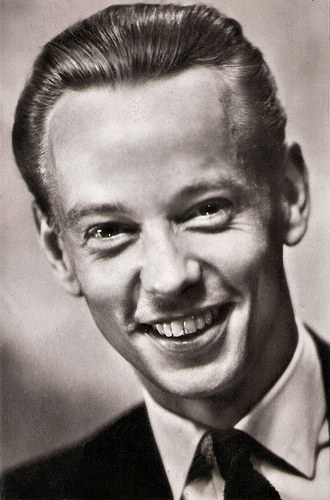
Dutch postcard. Photo: Godfried de Groot.
Informant for the CIA in Berlin
Rijk de Gooyer was born in Utrecht, Netherlands, in 1925 as one half of a fraternal twin. His father was a baker.
At the end of World War II, Rijk worked as an interpreter. Initially for the American 101st Airborne, later on for the British Field Security.
One of his first screen credits was a part in the American TV series Secret File, U.S.A. (1955), filmed in the Netherlands for syndicated TV in the USA.
He also played in the Dutch films Het wonderlijke Leven van Willem Parel/The amazing life of Willem Parel (Gerard Rutten, 1955) featuring Wim Sonneveld , and Kleren maken de man/Clothes make the man (Georg Jacoby, 1957), starring Kees Brusse.
From 1959 till 1961 de Gooyer studied at an actors school of the Ufa in Berlin. During these years, he would have worked for the CIA as an informant. In Germany, he appeared in the film Schachnovelle/Brainwashed (Gerd Oswald, 1960) starring Curd Jürgens .
Back in the Netherlands, he played parts in the crime films Rififi in Amsterdam (Giovanni Korporaal, 1962) and De blanke Slavin/The White Slave (Rene Daalder, 1969).
In the 1950s, he started a comic duo with Johnny Kraaykamp . Thanks to their performances on TV, the duo became extremely popular. In the Johnny & Rijk shows on TV, De Gooyer always played the part of the feeder, with Kraaijkamp providing the laughs. They split up in the 1970s, when De Gooyer focused more on his film career.
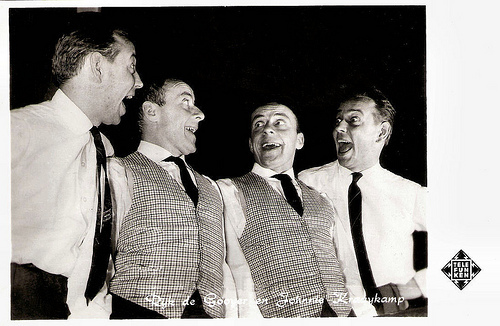
Rijk de Gooijer and Johnny Kraaykamp . Dutch postcard by Editions Altona, Amsterdam / Gebr. Spanjersberg, Rotterdam. Photo: Telefunken.
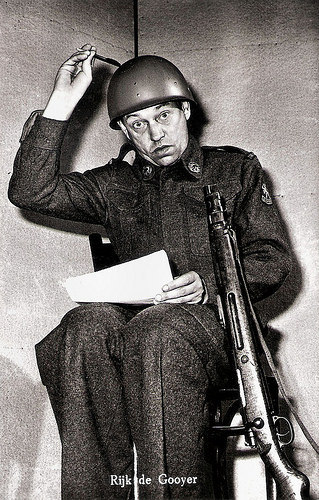
Dutch postcard by Gebr. Spanjersberg N.V., Rotterdam (Sparo), no. 1111. Photo: Artone. The song Brief uit La Courtine (Letter from La Courtine) was written by Eli Asser and a hit in 1964.

Dutch postcard. Publicity still for the TV film Quitte of dubbel/Double or quits (Hank Onrust, 1977) with Ronnie Bierman.
The Burglar and Nosferatu
Rijk de Gooyer played his first lead role in the cinema as master safe-cracker Glimmie in the crime film De inbreker/The Burglar (Frans Weisz, 1972). Martin Smith at IMDb : “Rijk de Gooyer is at his best in this movie. Like in real life, Rijk is humorous, tough and resourcefully. John Blooming (sic, Jon Bluming), a Dutch martial arts expert and trainer of the Dutch Olympic Karate team a long time ago, plays the role of the big, strong but not too bright sidekick very convincing. His massive appearance says more than words. I saw this movie many years ago and it always stuck in my mind.”
The success of the film lead to other lead roles in thrillers like Naakt over de schutting/Naked Over the Fence (Frans Weisz, 1973) with Jon Bluming and Sylvia Kristel , and Rufus (Samuel Meyering, 1975) with Cox Habbema . He also played a supporting part in the British ant-apartheids thriller The Wilby Conspiracy (Ralph Nelson, 1975), starring Michael Caine and Sidney Poitier.
Memorable is his role as a Gestapo agent in the war film Soldaat van Oranje/Soldier of Orange (Paul Verhoeven, 1977). The film, starring Rutger Hauer and Jeroen Krabbé , became one of the most successful films of the Dutch cinema. Another masterpiece was Werner Herzog’s Nosferatu: Phantom der Nacht/Nosferatu the Vampyre (1979) with Klaus Kinski as Count Dracula. De Gooyer played a supporting role as a town official.
De Gooijer continued to appear regularly in Dutch and international films. His best films include Een vlucht regenwulpen/A flight of rainbirds (Ate de Jong, 1981), Vroeger kon je lachen/One Could Laugh in Former Days (Bert Haanstra, 1983) and Ciske de Rat/ Ciske the Rat (Guido Pieters, 1984). In 1982 he won the Golden Calf at the NFF for Best Actor for all his works. He continued to play excellent roles in interesting films like the Jewish drama Leedvermaak/Polonaise (Frans Weisz, 1989) and the literary adaptation De avonden/Evenings (Rudolf van den Berg, 1989) as the father of Frits van Egters (Thom Hoffman).
In 1995 he again won the Golden Calf for his role as a former vaudevillian who tries one last time to find the dignity of a legitimate role in Hoogste Tijd/The Last Call (Frans Weisz, 1995). De Gooyer was videotaped afterwards while he threw the award out of the window of a cab for the TV show Taxi (the Dutch version of Taxicab Confessions). His last Golden Calf, for Madelief, Krassen in het Tafelblad/Daisy (Ineke Houtman, 1998) was also thrown out on the street, this time by his friend Maarten Spanjer who hosted Taxi.
De Gooyer was also the lead in the TV series In voor- en tegenspoed/In Sickness and in Health (1991-1997), the Dutch version of Johnny Speight's sitcom franchise known in the UK as Till Death Us Do Part and in the US as All in the Family. De Gooyer played Fred Schuit, the Dutch equivalent of Alf Garnett or Archie Bunker. He won a Golden Film in 1997 for the role. His final film was Happy End (Frans Weisz, 2009). Rijk de Gooyer died in 2011 in Amsterdam, Netherlands. He was 85. He was married to Tonny Domburg, sister of actress Andrea Domburg .
Rijk de Gooijer & Johnny Kraaijkamp Senior perform their hit song Waterlooplein in one of their TV shows. Source: mervinproducties (YouTube).
De inbreker/The Burglar (Frans Weisz, 1972). Full movie! Sorry, no subtitles. Source: Draadloosstroom (YouTube).
Danish (!) trailer for The Wilby Conspiracy (Ralph Nelson, 1975). Source: Joenke 77 (YouTube).
Dutch trailer for the crime film Grijpstra en de Gier/Fatal Error (Wim Verstappen, 1979) with Rutger Hauer . Source: Camero Piyawat (YouTube).
The legendary fragment from Taxi (1995). Source: Kanaal van 1000birds (YouTube).
Sources: Martin Smith (IMDb), AllMovie, Wikipedia and .

Dutch postcard. Photo: Godfried de Groot.
Informant for the CIA in Berlin
Rijk de Gooyer was born in Utrecht, Netherlands, in 1925 as one half of a fraternal twin. His father was a baker.
At the end of World War II, Rijk worked as an interpreter. Initially for the American 101st Airborne, later on for the British Field Security.
One of his first screen credits was a part in the American TV series Secret File, U.S.A. (1955), filmed in the Netherlands for syndicated TV in the USA.
He also played in the Dutch films Het wonderlijke Leven van Willem Parel/The amazing life of Willem Parel (Gerard Rutten, 1955) featuring Wim Sonneveld , and Kleren maken de man/Clothes make the man (Georg Jacoby, 1957), starring Kees Brusse.
From 1959 till 1961 de Gooyer studied at an actors school of the Ufa in Berlin. During these years, he would have worked for the CIA as an informant. In Germany, he appeared in the film Schachnovelle/Brainwashed (Gerd Oswald, 1960) starring Curd Jürgens .
Back in the Netherlands, he played parts in the crime films Rififi in Amsterdam (Giovanni Korporaal, 1962) and De blanke Slavin/The White Slave (Rene Daalder, 1969).
In the 1950s, he started a comic duo with Johnny Kraaykamp . Thanks to their performances on TV, the duo became extremely popular. In the Johnny & Rijk shows on TV, De Gooyer always played the part of the feeder, with Kraaijkamp providing the laughs. They split up in the 1970s, when De Gooyer focused more on his film career.

Rijk de Gooijer and Johnny Kraaykamp . Dutch postcard by Editions Altona, Amsterdam / Gebr. Spanjersberg, Rotterdam. Photo: Telefunken.

Dutch postcard by Gebr. Spanjersberg N.V., Rotterdam (Sparo), no. 1111. Photo: Artone. The song Brief uit La Courtine (Letter from La Courtine) was written by Eli Asser and a hit in 1964.

Dutch postcard. Publicity still for the TV film Quitte of dubbel/Double or quits (Hank Onrust, 1977) with Ronnie Bierman.
The Burglar and Nosferatu
Rijk de Gooyer played his first lead role in the cinema as master safe-cracker Glimmie in the crime film De inbreker/The Burglar (Frans Weisz, 1972). Martin Smith at IMDb : “Rijk de Gooyer is at his best in this movie. Like in real life, Rijk is humorous, tough and resourcefully. John Blooming (sic, Jon Bluming), a Dutch martial arts expert and trainer of the Dutch Olympic Karate team a long time ago, plays the role of the big, strong but not too bright sidekick very convincing. His massive appearance says more than words. I saw this movie many years ago and it always stuck in my mind.”
The success of the film lead to other lead roles in thrillers like Naakt over de schutting/Naked Over the Fence (Frans Weisz, 1973) with Jon Bluming and Sylvia Kristel , and Rufus (Samuel Meyering, 1975) with Cox Habbema . He also played a supporting part in the British ant-apartheids thriller The Wilby Conspiracy (Ralph Nelson, 1975), starring Michael Caine and Sidney Poitier.
Memorable is his role as a Gestapo agent in the war film Soldaat van Oranje/Soldier of Orange (Paul Verhoeven, 1977). The film, starring Rutger Hauer and Jeroen Krabbé , became one of the most successful films of the Dutch cinema. Another masterpiece was Werner Herzog’s Nosferatu: Phantom der Nacht/Nosferatu the Vampyre (1979) with Klaus Kinski as Count Dracula. De Gooyer played a supporting role as a town official.
De Gooijer continued to appear regularly in Dutch and international films. His best films include Een vlucht regenwulpen/A flight of rainbirds (Ate de Jong, 1981), Vroeger kon je lachen/One Could Laugh in Former Days (Bert Haanstra, 1983) and Ciske de Rat/ Ciske the Rat (Guido Pieters, 1984). In 1982 he won the Golden Calf at the NFF for Best Actor for all his works. He continued to play excellent roles in interesting films like the Jewish drama Leedvermaak/Polonaise (Frans Weisz, 1989) and the literary adaptation De avonden/Evenings (Rudolf van den Berg, 1989) as the father of Frits van Egters (Thom Hoffman).
In 1995 he again won the Golden Calf for his role as a former vaudevillian who tries one last time to find the dignity of a legitimate role in Hoogste Tijd/The Last Call (Frans Weisz, 1995). De Gooyer was videotaped afterwards while he threw the award out of the window of a cab for the TV show Taxi (the Dutch version of Taxicab Confessions). His last Golden Calf, for Madelief, Krassen in het Tafelblad/Daisy (Ineke Houtman, 1998) was also thrown out on the street, this time by his friend Maarten Spanjer who hosted Taxi.
De Gooyer was also the lead in the TV series In voor- en tegenspoed/In Sickness and in Health (1991-1997), the Dutch version of Johnny Speight's sitcom franchise known in the UK as Till Death Us Do Part and in the US as All in the Family. De Gooyer played Fred Schuit, the Dutch equivalent of Alf Garnett or Archie Bunker. He won a Golden Film in 1997 for the role. His final film was Happy End (Frans Weisz, 2009). Rijk de Gooyer died in 2011 in Amsterdam, Netherlands. He was 85. He was married to Tonny Domburg, sister of actress Andrea Domburg .
Rijk de Gooijer & Johnny Kraaijkamp Senior perform their hit song Waterlooplein in one of their TV shows. Source: mervinproducties (YouTube).
De inbreker/The Burglar (Frans Weisz, 1972). Full movie! Sorry, no subtitles. Source: Draadloosstroom (YouTube).
Danish (!) trailer for The Wilby Conspiracy (Ralph Nelson, 1975). Source: Joenke 77 (YouTube).
Dutch trailer for the crime film Grijpstra en de Gier/Fatal Error (Wim Verstappen, 1979) with Rutger Hauer . Source: Camero Piyawat (YouTube).
The legendary fragment from Taxi (1995). Source: Kanaal van 1000birds (YouTube).
Sources: Martin Smith (IMDb), AllMovie, Wikipedia and .
Published on September 22, 2015 22:00
September 21, 2015
Brigitte Fossey
French actress Brigitte Fossey (1946) made her first film when she was only five, the classic Jeux interdits/Forbidden Games (1952). As an adult, the lovely, sensitive-appearing blonde actress worked with such directors as François Truffaut, Bertrand Blier and Robert Altman.
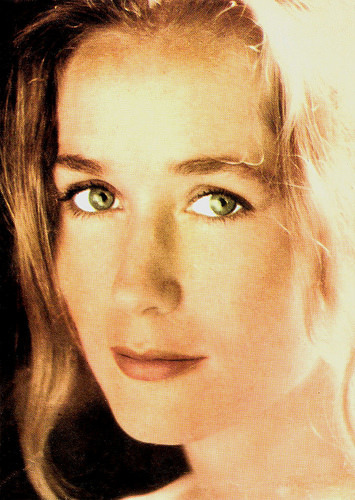
Romanian postcard by Casa Filmului Acin, no. 667.
Forbidden Games
Brigitte Fossey was born in Tourcoing in the north of France in 1946. She was the daughter of Roger Fossey, a schoolteacher, and Marcelle Feuillade.
Fossey was five years old when she was cast by director René Clément to star in his war film, Jeux interdits/Forbidden Games (1952). After the shooting, she received a beautiful red bicycle as her wages.
Fossey played the role of Paulette, a little French girl who is orphaned in a Nazi air attack. She is befriended by the son of a poor farmer (Georges Poujouly), and together they try to come to terms with the realities of death. Mario Gauci calls it at IMDb : “one of the most poignant (and controversial) depictions of childhood innocence on film.”
While not initially successful in France, the film was a hit elsewhere. It won the Golden Lion at the Venice Film Festival, the Oscar as Best Foreign Language Film, and a BAFTA award. In Italy, she played the lead role in the drama La corda d'acciaio/The Steel Rope (Carlo Borghesio, 1953) with Fausto Tozzi and Virna Lisi .
Fossey was then hired by American actor/director Gene Kelly for his French-American comedy The Happy Road (1957) with Barbara Laage . It was filmed in the studios of Billancourt. When Fossey was ten years old her parents took her out of the film business so she could receive proper schooling. While completing her education, Fossey studied piano and dance and then went on to work briefly in Geneva, Switzerland as an interpreter and translator.
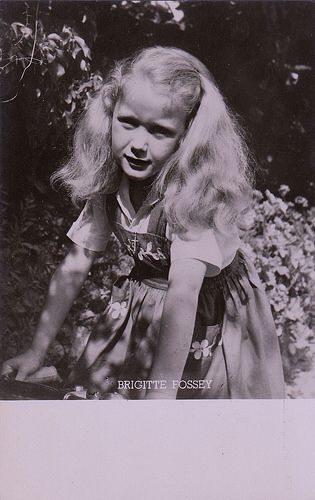
French or Belgian postcard, no. 353. Collection: Marlene Pilaete.
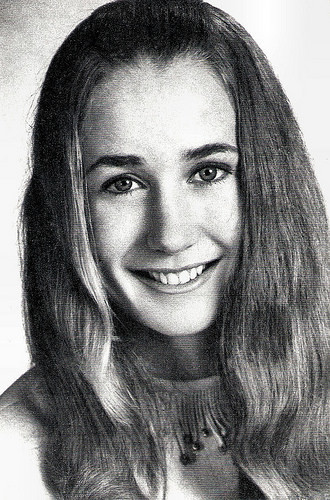
Romanian postcard by Casa Filmului Acin, no. 164.
Les Valseuses
Brigitte Fossey returned to Paris and studied acting at the Conservatory of Dramatic Art. In 1967, at the age of twenty, Fossey was offered the female lead by director Jean-Gabriel Albicocco for his film Le Grand Meaulnes/The Great Meaulnes based on Alain-Fournier's classic novel of young love.
After the popular success of this film, new proposals began to flow. Next she appeared in the box-office hit Adieu l’ami/Farewell Friend (Jean Herman, 1968), starring Alain Delon and Charles Bronson. A cult success was the French comedy-drama Les Valseuses/Going places (Bertrand Blier, 1974), starring Miou-Miou, Gérard Depardieu and Patrick Dewaere . Fossey played a supporting part. She also appeared in Blier’s sex comedy Calmos/Cool, Calm and Collected (Bertrand Blier, 1976) as the wife of Jean-Pierre Marielle.
One of her best known films is Truffaut’s comedy/drama L'Homme qui aimait les femmes/The Man Who Loved Women (François Truffaut, 1977). She interpreted an editor, wise counselor and ultimate conquest of Charles Denner.
Twice, she was nominated for a César Award. In 1977 for Best Actress a Supporting Role for Le Bon et les méchants/The Good and the Bad (Claude Lelouch, 1976), and in 1978 for Best Actress for Les Enfants du placard/Closet Children (Benoît Jacquot, 1977).
She also played opposite Helmut Griem in the West German crime film Die gläserne Zelle/The Glass Cell (Hans W. Geißendörfer, 1978). It was nominated for the Academy Award for Best Foreign Language Film. Fluent in English, Fossey has appeared in a few Hollywood movies. She played the wife of Paul Newman in the post-apocalyptic Science-Fiction film Quintet (Robert Altman, 1979).
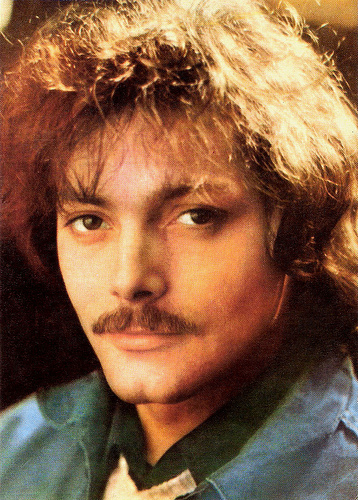
Patrick Dewaere . Romanian postcard by Casa Filmului Acin, no. cd. 43 157.
Cinema Paradiso
As an adult, Brigitte Fossey acted both on stage (in plays by Anton Chekhov and Molière), and on screen. Very successfully, she played Sophie Marceau’s modern and gentle mother in the film comedy La Boum/The Party (Claude Pinoteau, 1980) about a thirteen-year-old French girl finding her way at a new high school and coping with domestic problems. The film was an international box-office hit, earning 4,378,500 admissions in France.
Two years later, she returned in the equally successful sequel, La Boum 2 (Claude Pinoteau, 1982). Fossey also played a former drug addict opposite Patrick Dewaere in Un mauvais fils/A Bad Son (Claude Sautet, 1980) and had a supporting part in the biography Chanel Solitaire (George Kaczender, 1981) starring Marie-France Pisier and Timothy Dalton .
In 1982, she was a member of the jury at the 32nd Berlin International Film Festival. In Germany, she played with Robert Powell in the philosophical drama Imperativ/Imperative (Krzysztof Zanussi, 1982). She next starred in the drama Au nom de tous les miens/For Those I Loved (Robert Enrico, 1983) with Michael York as a Polish Jewish Holocaust survivor who emigrated to the USA in 1946.
She played a small part in the Italian drama Nuovo Cinema Paradiso/Cinema Paradiso (Giuseppe Tornatore, 1988), but for the shorter foreign release of the film her scenes were cut. This international version won the Special Jury Prize at the 1989 Cannes Film Festival and the 1989 Best Foreign Language Film Oscar. In 2002, the director's cut 173-minute version was released including the scenes with Fossey.
In 1992, she co-starred with legendary Jean Marais in the adventure film Les Enfants du naufrageur/Shipwrecked Children (Jérôme Foulon, 1992). During the 1990s, she began performing in television productions and some of her series became very popular in France. Her most recent TV series is Jusqu'au dernier/Until the last (François Velle, 2014). Brigitte Fossey was married from 1966 till 1980 to director Jean-François Adam, with whom she made the film M comme Mathieu/'M' as in Mathieu (1973). They have a daughter, actress Marie Adam.
Trailer for Jeux interdits/Forbidden Games (1952). Source: Rialto Film (YouTube).
Source: Yvan Foucart (L’encinémathèque – French), Brigitte Baronnet (AlloCiné – French), Wikipedia, and .

Romanian postcard by Casa Filmului Acin, no. 667.
Forbidden Games
Brigitte Fossey was born in Tourcoing in the north of France in 1946. She was the daughter of Roger Fossey, a schoolteacher, and Marcelle Feuillade.
Fossey was five years old when she was cast by director René Clément to star in his war film, Jeux interdits/Forbidden Games (1952). After the shooting, she received a beautiful red bicycle as her wages.
Fossey played the role of Paulette, a little French girl who is orphaned in a Nazi air attack. She is befriended by the son of a poor farmer (Georges Poujouly), and together they try to come to terms with the realities of death. Mario Gauci calls it at IMDb : “one of the most poignant (and controversial) depictions of childhood innocence on film.”
While not initially successful in France, the film was a hit elsewhere. It won the Golden Lion at the Venice Film Festival, the Oscar as Best Foreign Language Film, and a BAFTA award. In Italy, she played the lead role in the drama La corda d'acciaio/The Steel Rope (Carlo Borghesio, 1953) with Fausto Tozzi and Virna Lisi .
Fossey was then hired by American actor/director Gene Kelly for his French-American comedy The Happy Road (1957) with Barbara Laage . It was filmed in the studios of Billancourt. When Fossey was ten years old her parents took her out of the film business so she could receive proper schooling. While completing her education, Fossey studied piano and dance and then went on to work briefly in Geneva, Switzerland as an interpreter and translator.

French or Belgian postcard, no. 353. Collection: Marlene Pilaete.

Romanian postcard by Casa Filmului Acin, no. 164.
Les Valseuses
Brigitte Fossey returned to Paris and studied acting at the Conservatory of Dramatic Art. In 1967, at the age of twenty, Fossey was offered the female lead by director Jean-Gabriel Albicocco for his film Le Grand Meaulnes/The Great Meaulnes based on Alain-Fournier's classic novel of young love.
After the popular success of this film, new proposals began to flow. Next she appeared in the box-office hit Adieu l’ami/Farewell Friend (Jean Herman, 1968), starring Alain Delon and Charles Bronson. A cult success was the French comedy-drama Les Valseuses/Going places (Bertrand Blier, 1974), starring Miou-Miou, Gérard Depardieu and Patrick Dewaere . Fossey played a supporting part. She also appeared in Blier’s sex comedy Calmos/Cool, Calm and Collected (Bertrand Blier, 1976) as the wife of Jean-Pierre Marielle.
One of her best known films is Truffaut’s comedy/drama L'Homme qui aimait les femmes/The Man Who Loved Women (François Truffaut, 1977). She interpreted an editor, wise counselor and ultimate conquest of Charles Denner.
Twice, she was nominated for a César Award. In 1977 for Best Actress a Supporting Role for Le Bon et les méchants/The Good and the Bad (Claude Lelouch, 1976), and in 1978 for Best Actress for Les Enfants du placard/Closet Children (Benoît Jacquot, 1977).
She also played opposite Helmut Griem in the West German crime film Die gläserne Zelle/The Glass Cell (Hans W. Geißendörfer, 1978). It was nominated for the Academy Award for Best Foreign Language Film. Fluent in English, Fossey has appeared in a few Hollywood movies. She played the wife of Paul Newman in the post-apocalyptic Science-Fiction film Quintet (Robert Altman, 1979).

Patrick Dewaere . Romanian postcard by Casa Filmului Acin, no. cd. 43 157.
Cinema Paradiso
As an adult, Brigitte Fossey acted both on stage (in plays by Anton Chekhov and Molière), and on screen. Very successfully, she played Sophie Marceau’s modern and gentle mother in the film comedy La Boum/The Party (Claude Pinoteau, 1980) about a thirteen-year-old French girl finding her way at a new high school and coping with domestic problems. The film was an international box-office hit, earning 4,378,500 admissions in France.
Two years later, she returned in the equally successful sequel, La Boum 2 (Claude Pinoteau, 1982). Fossey also played a former drug addict opposite Patrick Dewaere in Un mauvais fils/A Bad Son (Claude Sautet, 1980) and had a supporting part in the biography Chanel Solitaire (George Kaczender, 1981) starring Marie-France Pisier and Timothy Dalton .
In 1982, she was a member of the jury at the 32nd Berlin International Film Festival. In Germany, she played with Robert Powell in the philosophical drama Imperativ/Imperative (Krzysztof Zanussi, 1982). She next starred in the drama Au nom de tous les miens/For Those I Loved (Robert Enrico, 1983) with Michael York as a Polish Jewish Holocaust survivor who emigrated to the USA in 1946.
She played a small part in the Italian drama Nuovo Cinema Paradiso/Cinema Paradiso (Giuseppe Tornatore, 1988), but for the shorter foreign release of the film her scenes were cut. This international version won the Special Jury Prize at the 1989 Cannes Film Festival and the 1989 Best Foreign Language Film Oscar. In 2002, the director's cut 173-minute version was released including the scenes with Fossey.
In 1992, she co-starred with legendary Jean Marais in the adventure film Les Enfants du naufrageur/Shipwrecked Children (Jérôme Foulon, 1992). During the 1990s, she began performing in television productions and some of her series became very popular in France. Her most recent TV series is Jusqu'au dernier/Until the last (François Velle, 2014). Brigitte Fossey was married from 1966 till 1980 to director Jean-François Adam, with whom she made the film M comme Mathieu/'M' as in Mathieu (1973). They have a daughter, actress Marie Adam.
Trailer for Jeux interdits/Forbidden Games (1952). Source: Rialto Film (YouTube).
Source: Yvan Foucart (L’encinémathèque – French), Brigitte Baronnet (AlloCiné – French), Wikipedia, and .
Published on September 21, 2015 22:00
September 20, 2015
Richard Greene
Darkly handsome British film and television actor Richard Greene (1918-1985) was a matinee idol of the late 1930s who appeared in more than 40 films. He was perhaps best known for the lead role in the long-running British TV series The Adventures of Robin Hood (1955-1960).
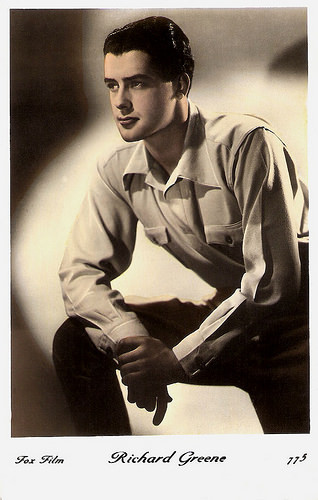
French postcard, no. 775. Photo: Fox Film.
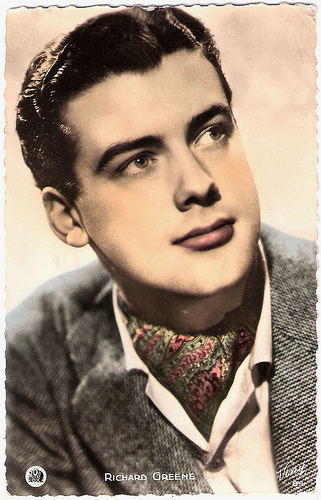
French postcard by Viny, no. 89. Photo: 20th Century Fox.
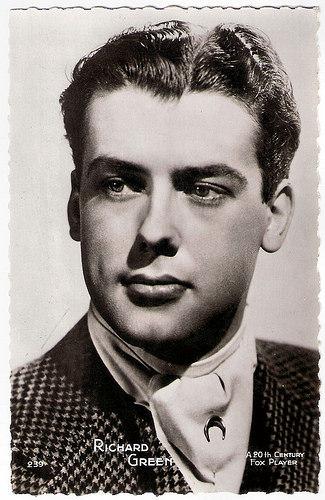
French postcard by Editions P.I., offered by Les Carbones Korès, no. 239. Photo: 20th Century Fox.
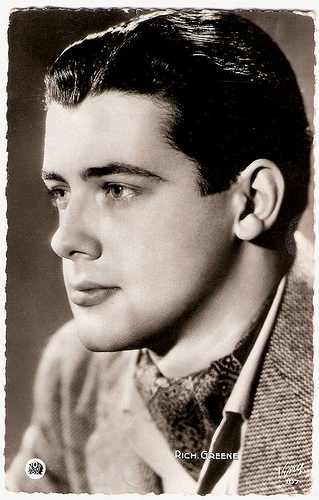
French postcard by Viny, no. 107. Photo: 20th Century Fox.
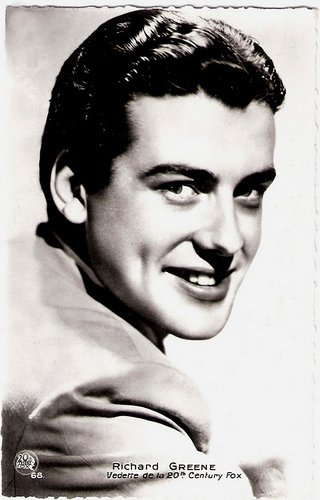
French postcard by Edit. Chantal, Rueil, no. 68. Photo: 20th Century Fox.
Exceedingly Good Looking
Richard Marius Joseph Greene was born in the port city of Plymouth, Devon, England, in 1918 (some sources say 1914). He was a descendant of four generations of actors. His father, Richard Abraham Greene and his mother, Kathleen Gerrard, were both actors with the Plymouth Repertory Theatre. His aunt was the musical theatre actress Evie Greene and his grandfather was film pioneer William Friese-Greene.
Greene was educated at the Cardinal Vaughn School in Kensington, where he left at the age of 14. He became determined to pursue the acting profession, making his stage debut in 1933 as a spear carrier in a production of William Shakespeare's Julius Caesar. He was an exceedingly good looking young man with an athletic build, dark wavy hair, and a pleasant speaking voice. He added to his income by modelling shirts and hats.
He played a small role in a 1934 revival of the play Journey's End and a bit part in the British musical film, Sing As We Go (Basil Dean, 1934), but the scene was deleted from the final version. In 1936, Greene joined the Brandon Thomas Company and learned his trade in repertory. He won accolades in the same year for his leading part in Terence Rattigan's French Without Tears, which brought him to the attention of a talent scout from 20th Century-Fox.
At 20, he signed a seven-year contract and went to Hollywood as a rival to MGM's Robert Taylor. The studio added 4 years to his age in all publicity materials. His first film for Fox was John Ford's Four Men and a Prayer (1938), in which he played the youngest of four British brothers in search of evidence to clear their disgraced colonel father ( C. Aubrey Smith ).
Greene was a huge success, especially with female filmgoers who sent him mountains of fan mail which at its peak rivalled that of Fox star Tyrone Power. Greene played a banker's son turned horse trainer in the popular horse breeding epic, Kentucky (David Butler, 1938) opposite Loretta Young, a college student estranged from his alcoholic father in Here I Am a Stranger (Roy Del Ruth, 1939), and steamboat inventor Robert Fulton in the fanciful historical drama Little Old New York (Henry King, 1940) with Alice Faye.
One of his most notable roles was Sir Henry Baskerville in the Sherlock Holmes film The Hound of the Baskervilles (Sidney Lanfield, 1939). The film also marked the first pairing of Basil Rathbone and Nigel Bruce as Sherlock Holmes and Dr. Watson.
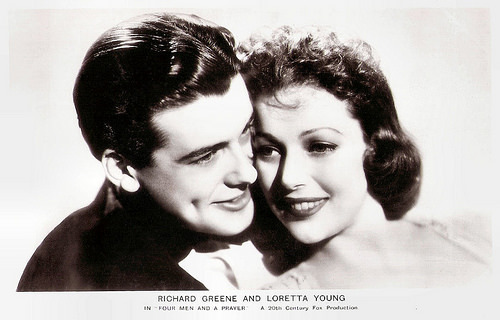
British postcard in the Picturegoer Series, London, no. FS 163. Photo: 20th Century Fox. Publicity still for Four men and a Prayer (John Ford, 1938) with Loretta Young.
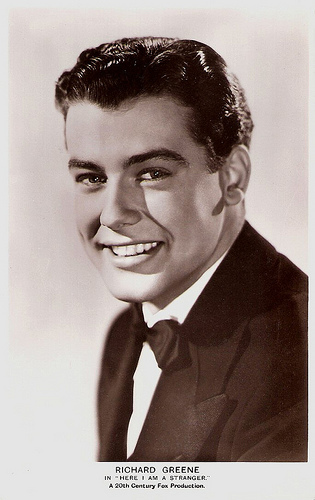
British postcard in the Picturegoer series, London, no. 1317. Photo: 20th Century Fox. Publicity still for Here I am an Stranger (Roy Del Ruth, 1939).
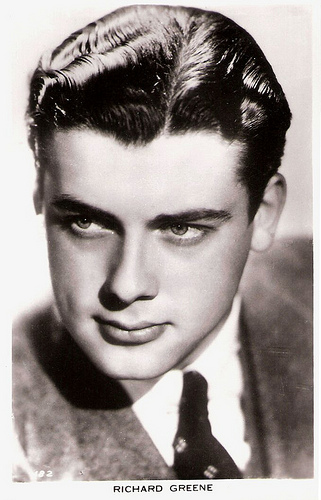
British postcard by Real Photograph.
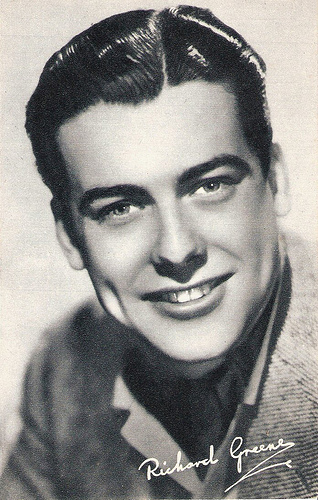
British postcard by Real Photogravure.
Swashbuckling Roles
In 1940, at the peak of his popularity, Richard Greene interrupted his Hollywood career to return to his homeland to aid in the war effort: an admirable personal decision which would have negative professional consequences. Enlisting in the Royal Armoured Corps of the Twenty Seventh Lancers, he distinguished himself throughout World War II eventually becoming a captain.
He was relieved from duty in 1942 to appear in the British propaganda films Flying Fortress (Walter Forde, 1942) and Unpublished Story (Harold French, 1942) with Valerie Hobson .
In 1943, he appeared in the thriller The Yellow Canary (Herbert Wilcox, 1943) with Anna Neagle while on furlough. He later toured in George Bernard Shaw's Arms and the Man, entertaining the troops. Greene was discharged in December 1944 and appeared in the stage plays Desert Rats and I Capture the Castle.
After the conflict ended, Greene and his young bride, beautiful British actress Patricia Medina (whom he had married in 1941) remained in England for a time where both appeared on stage and in British films. Richard's pictures included the charming comedy, Don't Take It to Heart (Jeffrey Dell, 1944), and the disappointing biopic about the Irish theatre entrepreneur George Howard, Gaiety George (George King, Leontine Sagan, 1946).
In 1946 Greene (accompanied by Medina who'd been offered a Fox contract) returned to Hollywood to complete his contract with 20th Century-Fox. When his dreams of regaining his lost momentum did not materialize, he opted to take whatever film work he could find. After landing a solid supporting role in the wildly popular costumer, Forever Amber (Otto Preminger, 1947), he found himself cast in a series of swashbuckling roles, the most memorable of which was The Black Castle (Nathan Juran, 1952) in which the heroic Greene battled Bela Lugosi and Boris Karloff.
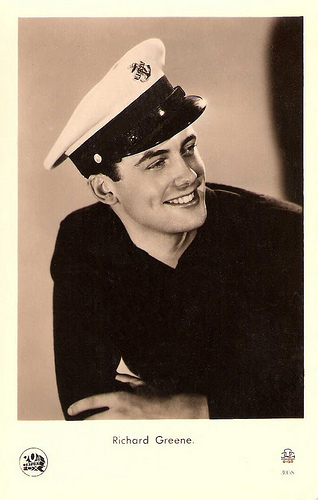
Latvian postcard by J.D.A., Riga, no. 3058. Photo: 20th Century Fox.
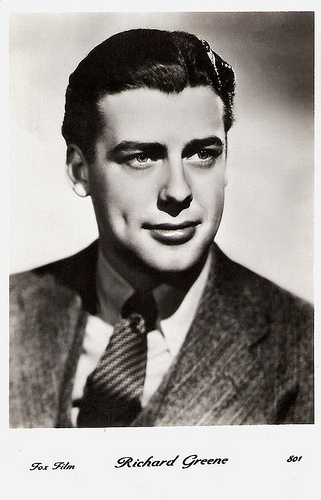
French postcard, no. 801. Photo: Fox Film.
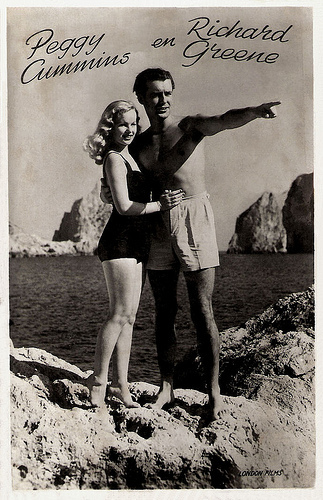
Dutch postcard. Photo: London Films. Publicity still for That Dangerous Age (Gregory Ratoff, 1949) with Peggy Cummins .
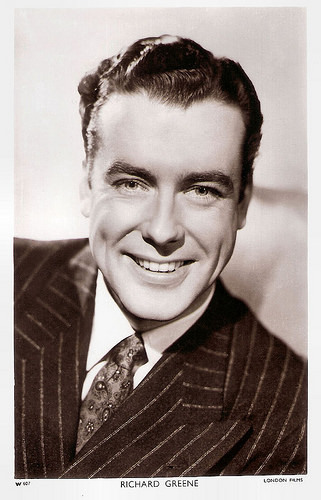
British postcard in the Picturegoer Series, London, no. W 607. Photo: London Films.
The Legendary Robin of Locksley
Richard Greene turned away from filmmaking in favour of the theater and television. During the early 1950s he had a long love affair with Nancy Oakes, wealthy daughter of mining tycoon Sir Harry Oakes. In 1951 their daughter Patricia Louise was born in Mexico City, while Greene was still married to Patricia Medina . Greene divorced from Medina a few months later.
By the mid 1950s his career was in decline. He had lost money on a play, The Lost Tent, which failed to reach the West End. He was disillusioned and cash-strapped when the British company Yeoman Films approached him in 1955. They offered him to play the legendary Robin of Locksley in The Adventures of Robin Hood, a series aimed at the American market.
The still youthful looking Greene eagerly signed on and was an immediate success. The Adventures of Robin Hood ran for 143 half hour episodes from 1955 to 1960. Some of the episodes were directed by the young Lindsay Anderson. It made Greene a major television star and solved his financial problems.
In 1960 he married Columbian heiress Beatriz Robledo-Summers. When The Adventures of Robin Hood ended they pursued together many of his hobbies including travelling, sailing, and breeding champion horses. In the 1960s and 1970s Greene appeared less and less interested in acting, only occasionally accepting roles in mostly forgettable action adventures and horror films, such as The Blood of Fu Manchu (Jesus Franco, 1968) and Tales from the Crypt (Freddie Francis, 1972). His TV work included episodes of The Professionals (1978) and Tales of the Unexpected (1979).
His second marriage ended in divorce in 1980. Two years later he suffered serious injuries in a fall followed by a diagnosis of a brain tumour. In the autumn of 1982 he underwent brain surgery from which he never fully recovered. Richard Greene died of cardiac arrest in 1985 in Norfolk, England. His daughter Patricia Leigh-Wood continued the theatrical tradition – she studied drama at Vassar College, New York. Her daughter Shirley Alice Leigh-Wood (1985) is an actress and dancer, who works under the stage name Shirley Oakes.
Trailer The Little Princess (1939). Source: Video Detective (YouTube).
Trailer for The Hound of the Baskervilles (1939). Source: Video Detective (YouTube).
Trailer for Lorna Doone (1951). Source: Buyout Footage Historic HD Film Archive (YouTube).
Leader of The Adventures of Robin Hood (1955-1960). Source: buzzzz1964 (YouTube).
Trailer for The Blood of Fu Manchu/Kiss and Kill (1968). Source: Film&Clips (YouTube).
Sources: (IMDb), Anna Fraser and Lucy Carpenter (Robin Hood TV), The Times, Wikipedia and .

French postcard, no. 775. Photo: Fox Film.

French postcard by Viny, no. 89. Photo: 20th Century Fox.

French postcard by Editions P.I., offered by Les Carbones Korès, no. 239. Photo: 20th Century Fox.

French postcard by Viny, no. 107. Photo: 20th Century Fox.

French postcard by Edit. Chantal, Rueil, no. 68. Photo: 20th Century Fox.
Exceedingly Good Looking
Richard Marius Joseph Greene was born in the port city of Plymouth, Devon, England, in 1918 (some sources say 1914). He was a descendant of four generations of actors. His father, Richard Abraham Greene and his mother, Kathleen Gerrard, were both actors with the Plymouth Repertory Theatre. His aunt was the musical theatre actress Evie Greene and his grandfather was film pioneer William Friese-Greene.
Greene was educated at the Cardinal Vaughn School in Kensington, where he left at the age of 14. He became determined to pursue the acting profession, making his stage debut in 1933 as a spear carrier in a production of William Shakespeare's Julius Caesar. He was an exceedingly good looking young man with an athletic build, dark wavy hair, and a pleasant speaking voice. He added to his income by modelling shirts and hats.
He played a small role in a 1934 revival of the play Journey's End and a bit part in the British musical film, Sing As We Go (Basil Dean, 1934), but the scene was deleted from the final version. In 1936, Greene joined the Brandon Thomas Company and learned his trade in repertory. He won accolades in the same year for his leading part in Terence Rattigan's French Without Tears, which brought him to the attention of a talent scout from 20th Century-Fox.
At 20, he signed a seven-year contract and went to Hollywood as a rival to MGM's Robert Taylor. The studio added 4 years to his age in all publicity materials. His first film for Fox was John Ford's Four Men and a Prayer (1938), in which he played the youngest of four British brothers in search of evidence to clear their disgraced colonel father ( C. Aubrey Smith ).
Greene was a huge success, especially with female filmgoers who sent him mountains of fan mail which at its peak rivalled that of Fox star Tyrone Power. Greene played a banker's son turned horse trainer in the popular horse breeding epic, Kentucky (David Butler, 1938) opposite Loretta Young, a college student estranged from his alcoholic father in Here I Am a Stranger (Roy Del Ruth, 1939), and steamboat inventor Robert Fulton in the fanciful historical drama Little Old New York (Henry King, 1940) with Alice Faye.
One of his most notable roles was Sir Henry Baskerville in the Sherlock Holmes film The Hound of the Baskervilles (Sidney Lanfield, 1939). The film also marked the first pairing of Basil Rathbone and Nigel Bruce as Sherlock Holmes and Dr. Watson.

British postcard in the Picturegoer Series, London, no. FS 163. Photo: 20th Century Fox. Publicity still for Four men and a Prayer (John Ford, 1938) with Loretta Young.

British postcard in the Picturegoer series, London, no. 1317. Photo: 20th Century Fox. Publicity still for Here I am an Stranger (Roy Del Ruth, 1939).

British postcard by Real Photograph.

British postcard by Real Photogravure.
Swashbuckling Roles
In 1940, at the peak of his popularity, Richard Greene interrupted his Hollywood career to return to his homeland to aid in the war effort: an admirable personal decision which would have negative professional consequences. Enlisting in the Royal Armoured Corps of the Twenty Seventh Lancers, he distinguished himself throughout World War II eventually becoming a captain.
He was relieved from duty in 1942 to appear in the British propaganda films Flying Fortress (Walter Forde, 1942) and Unpublished Story (Harold French, 1942) with Valerie Hobson .
In 1943, he appeared in the thriller The Yellow Canary (Herbert Wilcox, 1943) with Anna Neagle while on furlough. He later toured in George Bernard Shaw's Arms and the Man, entertaining the troops. Greene was discharged in December 1944 and appeared in the stage plays Desert Rats and I Capture the Castle.
After the conflict ended, Greene and his young bride, beautiful British actress Patricia Medina (whom he had married in 1941) remained in England for a time where both appeared on stage and in British films. Richard's pictures included the charming comedy, Don't Take It to Heart (Jeffrey Dell, 1944), and the disappointing biopic about the Irish theatre entrepreneur George Howard, Gaiety George (George King, Leontine Sagan, 1946).
In 1946 Greene (accompanied by Medina who'd been offered a Fox contract) returned to Hollywood to complete his contract with 20th Century-Fox. When his dreams of regaining his lost momentum did not materialize, he opted to take whatever film work he could find. After landing a solid supporting role in the wildly popular costumer, Forever Amber (Otto Preminger, 1947), he found himself cast in a series of swashbuckling roles, the most memorable of which was The Black Castle (Nathan Juran, 1952) in which the heroic Greene battled Bela Lugosi and Boris Karloff.

Latvian postcard by J.D.A., Riga, no. 3058. Photo: 20th Century Fox.

French postcard, no. 801. Photo: Fox Film.

Dutch postcard. Photo: London Films. Publicity still for That Dangerous Age (Gregory Ratoff, 1949) with Peggy Cummins .

British postcard in the Picturegoer Series, London, no. W 607. Photo: London Films.
The Legendary Robin of Locksley
Richard Greene turned away from filmmaking in favour of the theater and television. During the early 1950s he had a long love affair with Nancy Oakes, wealthy daughter of mining tycoon Sir Harry Oakes. In 1951 their daughter Patricia Louise was born in Mexico City, while Greene was still married to Patricia Medina . Greene divorced from Medina a few months later.
By the mid 1950s his career was in decline. He had lost money on a play, The Lost Tent, which failed to reach the West End. He was disillusioned and cash-strapped when the British company Yeoman Films approached him in 1955. They offered him to play the legendary Robin of Locksley in The Adventures of Robin Hood, a series aimed at the American market.
The still youthful looking Greene eagerly signed on and was an immediate success. The Adventures of Robin Hood ran for 143 half hour episodes from 1955 to 1960. Some of the episodes were directed by the young Lindsay Anderson. It made Greene a major television star and solved his financial problems.
In 1960 he married Columbian heiress Beatriz Robledo-Summers. When The Adventures of Robin Hood ended they pursued together many of his hobbies including travelling, sailing, and breeding champion horses. In the 1960s and 1970s Greene appeared less and less interested in acting, only occasionally accepting roles in mostly forgettable action adventures and horror films, such as The Blood of Fu Manchu (Jesus Franco, 1968) and Tales from the Crypt (Freddie Francis, 1972). His TV work included episodes of The Professionals (1978) and Tales of the Unexpected (1979).
His second marriage ended in divorce in 1980. Two years later he suffered serious injuries in a fall followed by a diagnosis of a brain tumour. In the autumn of 1982 he underwent brain surgery from which he never fully recovered. Richard Greene died of cardiac arrest in 1985 in Norfolk, England. His daughter Patricia Leigh-Wood continued the theatrical tradition – she studied drama at Vassar College, New York. Her daughter Shirley Alice Leigh-Wood (1985) is an actress and dancer, who works under the stage name Shirley Oakes.
Trailer The Little Princess (1939). Source: Video Detective (YouTube).
Trailer for The Hound of the Baskervilles (1939). Source: Video Detective (YouTube).
Trailer for Lorna Doone (1951). Source: Buyout Footage Historic HD Film Archive (YouTube).
Leader of The Adventures of Robin Hood (1955-1960). Source: buzzzz1964 (YouTube).
Trailer for The Blood of Fu Manchu/Kiss and Kill (1968). Source: Film&Clips (YouTube).
Sources: (IMDb), Anna Fraser and Lucy Carpenter (Robin Hood TV), The Times, Wikipedia and .
Published on September 20, 2015 22:00
September 19, 2015
From Holland with love: twelve postcards with Lien Deyers
Film historian Egbert Barten of the Geoffrey Donaldson Institute brought us newly acquired postcards for EFSP. In yesterday's film special on Riso Amaro/Bitter Rice (1949), some of the postcards were from the collection of the Geoffrey Donaldson Institute. Today we continue with a post on 12 of his recently acquired postcards of Lien Deyers (1910-1965). As a young girl, she was discovered by director Fritz Lang who gave her a part in Spione/Spies (1928). She acted in a stream of late silent and early sound films. After 1935 her star faded rapidly and her life ended in tragedy.
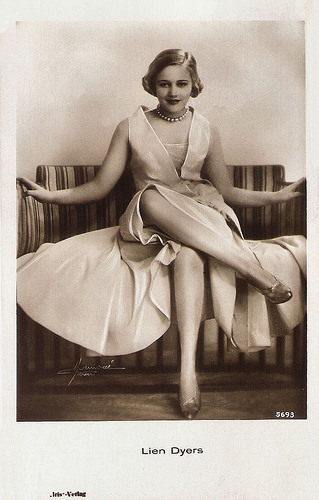
Austrian postcard by Iris Verlag, no. 5693. Photo: Manassé, Wien Collection: Geoffrey Donaldson Institute.
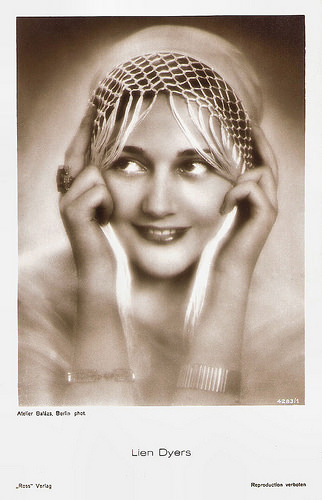
German postcard by Ross Verlag, no. 4283/1, 1929-1930. Photo: Atelier Balázs, Berlin. Collection: Geoffrey Donaldson Institute.
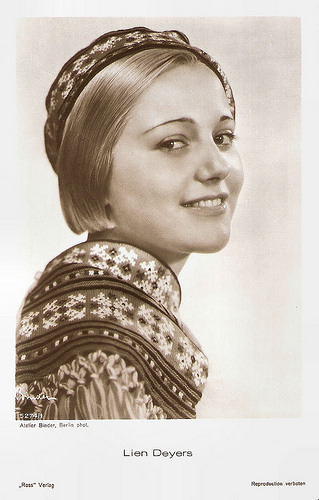
German postcard by Ross Verlag, no. 5274/1, 1930-1931. Photo: Atelier Binder. Collection: Geoffrey Donaldson Institute.
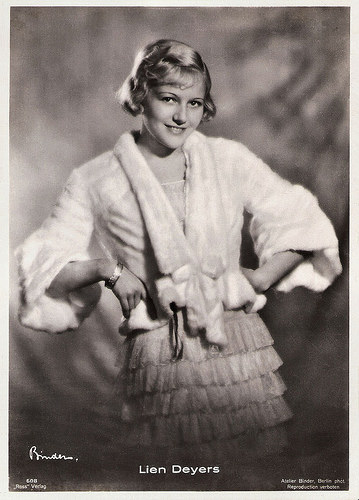
German postcard by Ross Verlag, no. 608 (Luxus series). Photo: Atelier Binder. Collection: Geoffrey Donaldson Institute.
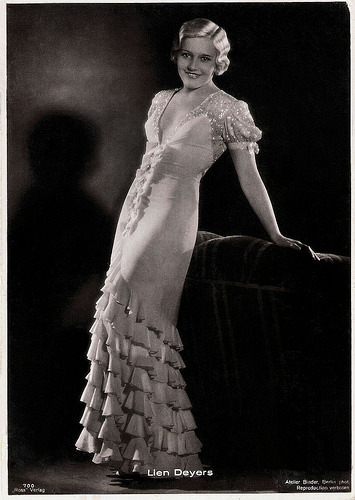
German postcard by Ross Verlag, no. 700 (Luxus series). Photo: Atelier Binder. Collection: Geoffrey Donaldson Institute.
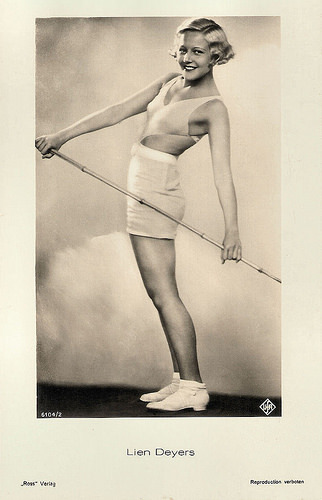
German postcard by Ross Verlag, no. 6104/2, 1931-1932. Photo: Ufa. Collection: Geoffrey Donaldson Institute.
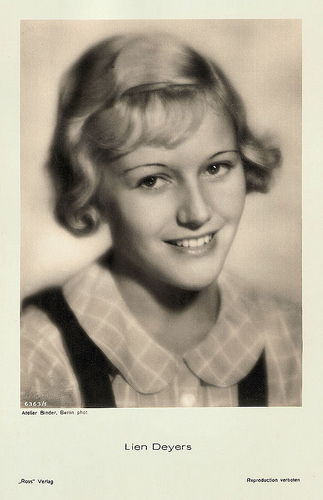
German postcard by Ross Verlag, no. 6363/1, 1931-1932. Photo: Atelier Binder. Collection: Geoffrey Donaldson Institute.
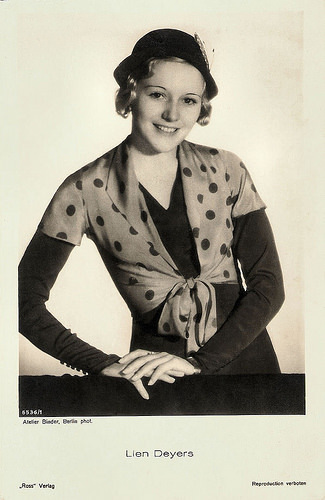
German postcard by Ross Verlag, no. 6536/1, 1931-1932. Photo: Atelier Binder. Collection: Geoffrey Donaldson Institute.
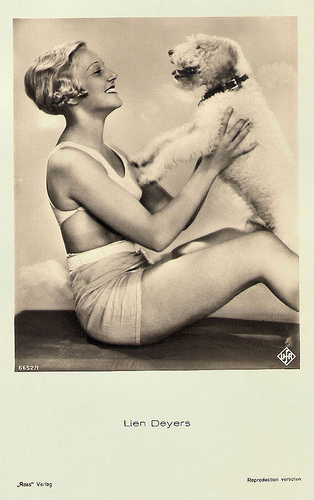
German postcard by Ross Verlag, no. 6552/1, 1931-1932. Photo: Ufa. Collection: Geoffrey Donaldson Institute.
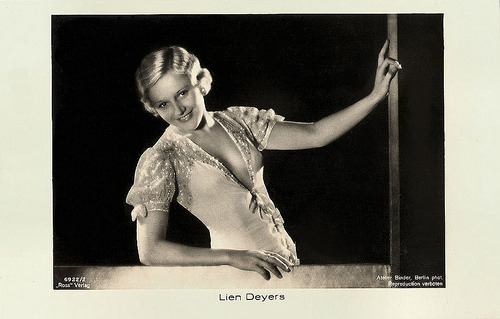
German postcard by Ross-Verlag, no. 6922/2, 1931-1932. Photo: Atelier Binder. Collection: Geoffrey Donaldson Institute.
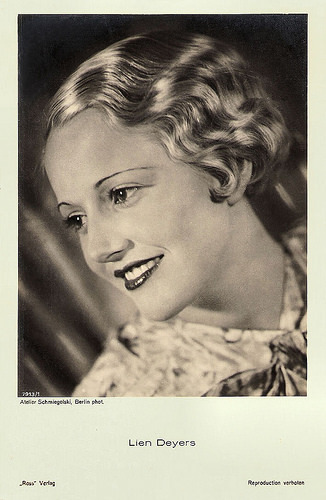
German postcard by Ross Verlag, no. 7913/1, 1932-1933. Photo: Atelier Schmiegelski, Berlin. Collection: Geoffrey Donaldson Institute.
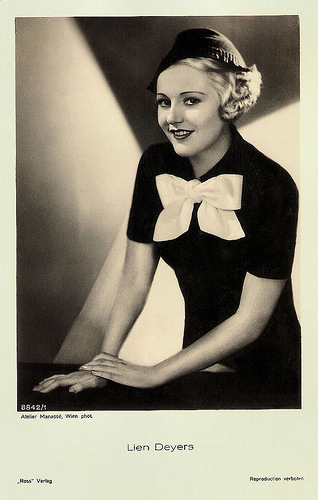
German postcard by Ross Verlag, no. 8842/1, 1933-1934. Photo: Atelier Manassé, Wien. Collection: Geoffrey Donaldson Institute.
Thanks, Egbert! For more information on the Geoffrey Donaldson Institute, check out the website (Dutch) or Facebook.

Austrian postcard by Iris Verlag, no. 5693. Photo: Manassé, Wien Collection: Geoffrey Donaldson Institute.

German postcard by Ross Verlag, no. 4283/1, 1929-1930. Photo: Atelier Balázs, Berlin. Collection: Geoffrey Donaldson Institute.

German postcard by Ross Verlag, no. 5274/1, 1930-1931. Photo: Atelier Binder. Collection: Geoffrey Donaldson Institute.

German postcard by Ross Verlag, no. 608 (Luxus series). Photo: Atelier Binder. Collection: Geoffrey Donaldson Institute.

German postcard by Ross Verlag, no. 700 (Luxus series). Photo: Atelier Binder. Collection: Geoffrey Donaldson Institute.

German postcard by Ross Verlag, no. 6104/2, 1931-1932. Photo: Ufa. Collection: Geoffrey Donaldson Institute.

German postcard by Ross Verlag, no. 6363/1, 1931-1932. Photo: Atelier Binder. Collection: Geoffrey Donaldson Institute.

German postcard by Ross Verlag, no. 6536/1, 1931-1932. Photo: Atelier Binder. Collection: Geoffrey Donaldson Institute.

German postcard by Ross Verlag, no. 6552/1, 1931-1932. Photo: Ufa. Collection: Geoffrey Donaldson Institute.

German postcard by Ross-Verlag, no. 6922/2, 1931-1932. Photo: Atelier Binder. Collection: Geoffrey Donaldson Institute.

German postcard by Ross Verlag, no. 7913/1, 1932-1933. Photo: Atelier Schmiegelski, Berlin. Collection: Geoffrey Donaldson Institute.

German postcard by Ross Verlag, no. 8842/1, 1933-1934. Photo: Atelier Manassé, Wien. Collection: Geoffrey Donaldson Institute.
Thanks, Egbert! For more information on the Geoffrey Donaldson Institute, check out the website (Dutch) or Facebook.
Published on September 19, 2015 22:00
September 18, 2015
Riso amaro/Bitter Rice (1949)
The Italian melodrama Riso amaro/Bitter Rice (1949) was a product of the Neo-Realism movement of the 1940s. The film was written and directed by Giuseppe De Santis and produced by Dino De Laurentiis for Lux Film. Bitter Rice was a commercial success in both Europe and America, thanks to the ‘shockingly’ sexy performance of Silvana Mangano, dressed in hotpants. The film also starred Raf Vallone, American actress Doris Dowling and a young Vittorio Gassman. The four become involved in a complex plot involving robbery, love, and murder.
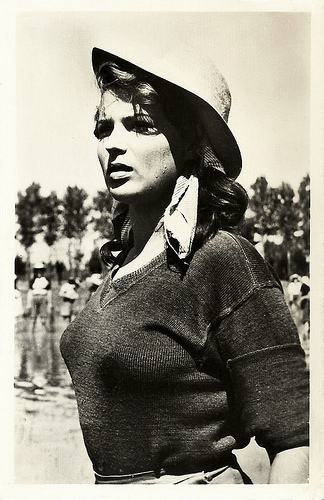
Dutch postcard by Filmverhuurkantoor Centrafilm, Dordrecht. Photo: Lux Film Rome. Publicity still for Riso amaro/Bitter Rice (Giuseppe de Santis, 1949) with Silvana Mangano .
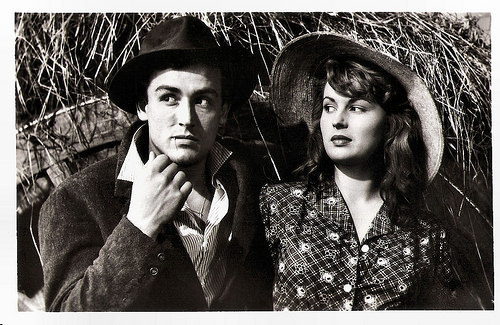
Dutch postcard by Centrafilm, Dordrecht. Photo: Vittorio Gassman and Silvana Mangano in Riso amaro/Bitter Rice (Giuseppe de Santis, 1949). Collection: Egbert Barten.
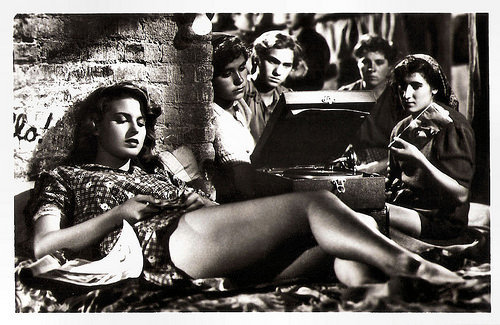
Dutch postcard by Centrafilm, Dordrecht. Photo: Silvana Mangano in Riso amaro/Bitter Rice (Giuseppe de Santis, 1949). Collection: Egbert Barten.
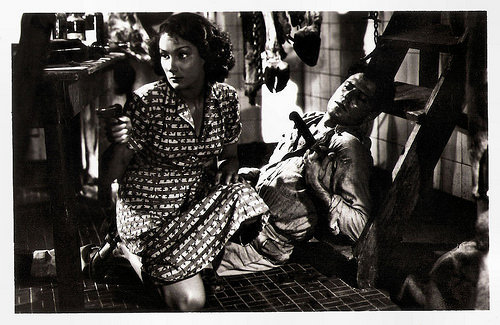
Dutch postcard by Centrafilm, Dordrecht. Photo: Doris Dowling and Raf Vallone in Riso amaro/Bitter Rice (Giuseppe de Santis, 1949). Collection: Egbert Barten.
Is Riso amaro a Neo-Realist film?
At the time, Neo-Realism was about only 7 years old. Films like Roma Citta Aperta by Roberto Rossellini had taken the world by storm, and overwhelmed international audiences and festival juries. But the Neo-Realist films quickly changed in character and Riso amaro/Bitter Rice lead to a dispute among film critics about the sexualization of the lead character and the melodramatic presence of death and suicide in the film.
At IMDb , Debblyst explains: “Neo-Realist principles (i.e. no stars, mix of professional and non-professional actors, location-only shooting, rejection of ‘beauty’/classicism/romanticism, stressing on ‘ordinary’ people and ‘real-life’ themes) were being stretched: stars were joining in (including international ones, like Ingrid Bergman , or starlets like American Doris Dowling here), productions got bigger and more expensive, crews more professional, equipment more sophisticated, ‘ordinary’ people were being replaced by Olympic beauties (or do ordinary people EVER look like Silvana Mangano or Vittorio Gassman ?), ‘ordinary’ characters were getting very complex, and real life was being traded by elaborate, far from realistic drama.”
Riso amaro begins at the start of the rice-planting season in northern Italy. Trying to escape the law, two small-time criminals, Francesca ( Doris Dowling ) and Walter ( Vittorio Gassman ), hide amongst the crowds of female workers heading to the rice fields of the Po Valley.
While attempting to board the train for the fields, the pair runs into Silvana ( Silvana Mangano ), a voluptuous peasant rice worker. Francesca boards the train with her, in an effort to avoid the police. Silvana introduces her to the planter's way of life. Francesca does not have a work permit, and struggles with the other ‘illegals’ to find a place on the rice fields. After initial resistance from documented workers and bosses, the scabs are allowed a place in the fields.
At the fields, Silvana and Francesca meet a soon-to-be-discharged soldier, Marco ( Raf Vallone ), who unsuccessfully tries to attract Silvana's interest. Toward the end of the working season, Walter arrives at the fields, intending to steal a large quantity of rice. Excited by his criminal lifestyle, Silvana becomes attracted to Walter. She causes a diversion to help him carry out the heist, but Francesca and Marco manage to stop Walter and his accomplices.
Francesca and Silvana face each other, armed with pistols; Francesca confronts Silvana and explains that she has been manipulated by Walter. In response, Silvana turns her gun toward Walter and murders him. Soon afterward, her guilt leads her to commit suicide. As the other rice workers depart, they pay tribute to her by sprinkling rice upon her body.
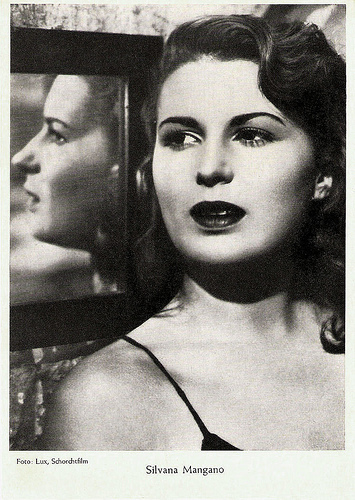
German collectors card. Photo: Lux / Schorchtfilm. Publicity still for Riso amaro/Bitter Rice (Giuseppe de Santis, 1949) with Silvana Mangano .
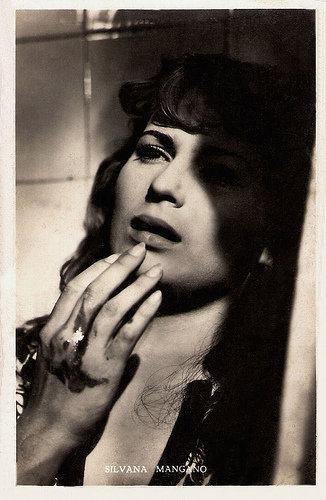
Belgian postcard by Nieuwe Merksemsche Chocolaterie, Merksem. Photo: Lux Film Rome. Publicity still for Riso amaro/Bitter Rice (Giuseppe de Santis, 1949) with Silvana Mangano .
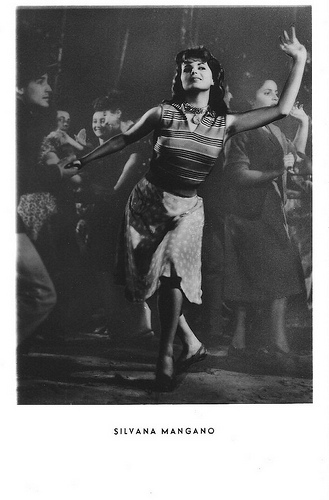
German postcard by Netter's Star Verlag, Berlin. Photo: Lux Film Rome. Publicity still for Riso amaro/Bitter Rice (Giuseppe de Santis, 1949) with Silvana Mangano .
Is Riso amaro merely a shocker?
The Italian title of the film, Riso amaro, is based on a pun. The Italian word ‘riso’ can mean either ‘rice’ or ‘laughter’, 'riso amaro' can be taken to mean either ‘bitter laughter’ or ‘bitter rice’.
Lucia Bosé was the director's first choice for the role of Silvana. It wasn't until he met former Miss Rome Silvana Mangano by chance that he decided to cast her in the film. In the film, Silvana chews gum and dances the boogie-woogie in an American way in the film. With her character’s downfall director Giuseppe De Santis's seems to have intended to show his condemnation of the products of American capitalism.
Ironically it was Silvana who made the film one of the biggest box office hits of the Neo-Realism cinema. To the standards of 1949, Mangano's performance in the film was shocking. Her hotpants and voluptuous figure earned Riso amaro a lot of publicity, in particular in strongly Roman Catholic Italy. But Riso amaro has more qualities than just being a shocker.
W. Visser at IMDb : “Although its mold of 1949 appears somewhat melodramatic today, the black and white Riso Amaro (= Italian for Bitter Rice) surely ranks among the classics in film history. This very Italian product by Giuseppe de Santis shows a pretty ordinary crime story, excellently interwoven with an impressive decor of harsh season labor in the rice-fields of Northern Italy. The thousands of women, up to their ankles in the water, breaking their backs in the burning sun to earn a few bucks, make a truly great setting.”
The film was selected as one of 100 Italian films to be saved, a collection of films that "changed the collective memory of the country between 1942 and 1978". The collection was established by the Venice Film Festival in collaboration with Cinecittà and curated by Fabio Ferzetti, with input from Gianni Amelio and other Italian film critics. Many of the films selected represent the ‘Golden Age’ of Italian cinema, which was manifested in the Neorealist movement.
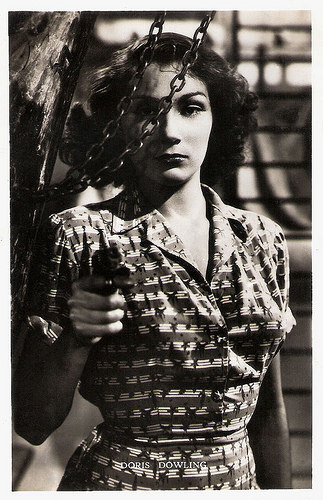
Belgian postcard by Nieuwe Merksemsche Chocolaterie S.P.R.L., Merksem (Anvers). Photo: Lux Film, Rome. Publicity still for Riso amaro/Bitter Rice (Giuseppe de Santis, 1949) with Doris Dowling.
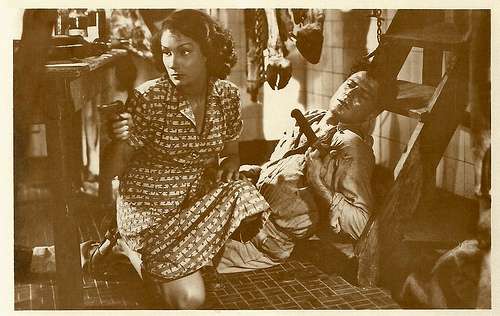
Dutch postcard by Centrafilm, Dordrecht. Photo: Lux. Doris Dowling and Raf Vallone in Riso amaro/Bitter Rice (Giuseppe de Santis, 1949).
Trailer Riso amaro/Bitter Rice (Giuseppe de Santis, 1949). Source: CG Entertainment (YouTube).
Sources: W. Visser (IMDb), Debbylyst (IMDb), Wikipedia and IMDb.

Dutch postcard by Filmverhuurkantoor Centrafilm, Dordrecht. Photo: Lux Film Rome. Publicity still for Riso amaro/Bitter Rice (Giuseppe de Santis, 1949) with Silvana Mangano .

Dutch postcard by Centrafilm, Dordrecht. Photo: Vittorio Gassman and Silvana Mangano in Riso amaro/Bitter Rice (Giuseppe de Santis, 1949). Collection: Egbert Barten.

Dutch postcard by Centrafilm, Dordrecht. Photo: Silvana Mangano in Riso amaro/Bitter Rice (Giuseppe de Santis, 1949). Collection: Egbert Barten.

Dutch postcard by Centrafilm, Dordrecht. Photo: Doris Dowling and Raf Vallone in Riso amaro/Bitter Rice (Giuseppe de Santis, 1949). Collection: Egbert Barten.
Is Riso amaro a Neo-Realist film?
At the time, Neo-Realism was about only 7 years old. Films like Roma Citta Aperta by Roberto Rossellini had taken the world by storm, and overwhelmed international audiences and festival juries. But the Neo-Realist films quickly changed in character and Riso amaro/Bitter Rice lead to a dispute among film critics about the sexualization of the lead character and the melodramatic presence of death and suicide in the film.
At IMDb , Debblyst explains: “Neo-Realist principles (i.e. no stars, mix of professional and non-professional actors, location-only shooting, rejection of ‘beauty’/classicism/romanticism, stressing on ‘ordinary’ people and ‘real-life’ themes) were being stretched: stars were joining in (including international ones, like Ingrid Bergman , or starlets like American Doris Dowling here), productions got bigger and more expensive, crews more professional, equipment more sophisticated, ‘ordinary’ people were being replaced by Olympic beauties (or do ordinary people EVER look like Silvana Mangano or Vittorio Gassman ?), ‘ordinary’ characters were getting very complex, and real life was being traded by elaborate, far from realistic drama.”
Riso amaro begins at the start of the rice-planting season in northern Italy. Trying to escape the law, two small-time criminals, Francesca ( Doris Dowling ) and Walter ( Vittorio Gassman ), hide amongst the crowds of female workers heading to the rice fields of the Po Valley.
While attempting to board the train for the fields, the pair runs into Silvana ( Silvana Mangano ), a voluptuous peasant rice worker. Francesca boards the train with her, in an effort to avoid the police. Silvana introduces her to the planter's way of life. Francesca does not have a work permit, and struggles with the other ‘illegals’ to find a place on the rice fields. After initial resistance from documented workers and bosses, the scabs are allowed a place in the fields.
At the fields, Silvana and Francesca meet a soon-to-be-discharged soldier, Marco ( Raf Vallone ), who unsuccessfully tries to attract Silvana's interest. Toward the end of the working season, Walter arrives at the fields, intending to steal a large quantity of rice. Excited by his criminal lifestyle, Silvana becomes attracted to Walter. She causes a diversion to help him carry out the heist, but Francesca and Marco manage to stop Walter and his accomplices.
Francesca and Silvana face each other, armed with pistols; Francesca confronts Silvana and explains that she has been manipulated by Walter. In response, Silvana turns her gun toward Walter and murders him. Soon afterward, her guilt leads her to commit suicide. As the other rice workers depart, they pay tribute to her by sprinkling rice upon her body.

German collectors card. Photo: Lux / Schorchtfilm. Publicity still for Riso amaro/Bitter Rice (Giuseppe de Santis, 1949) with Silvana Mangano .

Belgian postcard by Nieuwe Merksemsche Chocolaterie, Merksem. Photo: Lux Film Rome. Publicity still for Riso amaro/Bitter Rice (Giuseppe de Santis, 1949) with Silvana Mangano .

German postcard by Netter's Star Verlag, Berlin. Photo: Lux Film Rome. Publicity still for Riso amaro/Bitter Rice (Giuseppe de Santis, 1949) with Silvana Mangano .
Is Riso amaro merely a shocker?
The Italian title of the film, Riso amaro, is based on a pun. The Italian word ‘riso’ can mean either ‘rice’ or ‘laughter’, 'riso amaro' can be taken to mean either ‘bitter laughter’ or ‘bitter rice’.
Lucia Bosé was the director's first choice for the role of Silvana. It wasn't until he met former Miss Rome Silvana Mangano by chance that he decided to cast her in the film. In the film, Silvana chews gum and dances the boogie-woogie in an American way in the film. With her character’s downfall director Giuseppe De Santis's seems to have intended to show his condemnation of the products of American capitalism.
Ironically it was Silvana who made the film one of the biggest box office hits of the Neo-Realism cinema. To the standards of 1949, Mangano's performance in the film was shocking. Her hotpants and voluptuous figure earned Riso amaro a lot of publicity, in particular in strongly Roman Catholic Italy. But Riso amaro has more qualities than just being a shocker.
W. Visser at IMDb : “Although its mold of 1949 appears somewhat melodramatic today, the black and white Riso Amaro (= Italian for Bitter Rice) surely ranks among the classics in film history. This very Italian product by Giuseppe de Santis shows a pretty ordinary crime story, excellently interwoven with an impressive decor of harsh season labor in the rice-fields of Northern Italy. The thousands of women, up to their ankles in the water, breaking their backs in the burning sun to earn a few bucks, make a truly great setting.”
The film was selected as one of 100 Italian films to be saved, a collection of films that "changed the collective memory of the country between 1942 and 1978". The collection was established by the Venice Film Festival in collaboration with Cinecittà and curated by Fabio Ferzetti, with input from Gianni Amelio and other Italian film critics. Many of the films selected represent the ‘Golden Age’ of Italian cinema, which was manifested in the Neorealist movement.

Belgian postcard by Nieuwe Merksemsche Chocolaterie S.P.R.L., Merksem (Anvers). Photo: Lux Film, Rome. Publicity still for Riso amaro/Bitter Rice (Giuseppe de Santis, 1949) with Doris Dowling.

Dutch postcard by Centrafilm, Dordrecht. Photo: Lux. Doris Dowling and Raf Vallone in Riso amaro/Bitter Rice (Giuseppe de Santis, 1949).
Trailer Riso amaro/Bitter Rice (Giuseppe de Santis, 1949). Source: CG Entertainment (YouTube).
Sources: W. Visser (IMDb), Debbylyst (IMDb), Wikipedia and IMDb.
Published on September 18, 2015 22:00
September 17, 2015
Stefania Sandrelli
Sensual, vivacious and very talented Italian actress Stefania Sandrelli (1946) is famous for her roles in the Commedia all'Italiana. She was 15 years old when she had her breakthrough opposite Marcello Mastroianni in the Oscar winning comedy Divorzio all'italiana/Divorce, Italian Style (1961). Later she also played dramatic roles in Italian classics like Ettore Scola's C'eravamo tanto amati, and Bernardo Bertolucci’s Il Conformista/The Conformist (1970) and Novecento/1900 (1976).

Romanian postcard by Casa Filmului Acin.
Divorce, Italian Style
Stefania Sandrelli was born in Viareggio, Tuscany, into a middle-class family, in 1946. She was the daughter of Florida and Otello Sandrelli, owners of a well known pension in Viareggio. Her father died when Stefania was eight years old. She has a brother, Sergio, seven years older, who had a successful music career and died in 2013.
At a young age she learned to play the accordion, and studied ballet. In 1960 Sandrelli won the Miss Cinema Viareggio beauty contest. Next she was the cover girl of the magazine Le Ore and made her cinema debut in Gioventù di note/Youth at night (Mario Sequi, 1961) with Samy Frey and Magali Noël . Her second role was as a confidence trickster and petty thief in the war film Il federale/The Fascist (Luciano Salce, 1961), starring Ugo Tognazzi .
Her film career was definitively launched when she appeared as Marcello Mastroianni 's seductive, young cousin, Angela in Divorzio all'italiana/Divorce, Italian Style (Pietro Germi, 1961). The film won an Oscar for Best Original Script. With director Pietro Germi she later worked three more times: in the dark satire of Sicilian social customs and honour laws Sedotta e abbandonata/Seduced and Abandoned (1963), the comedy L'immorale/The Immoralist (1967) featuring Ugo Tognazzi , and Alfredo, Alfredo (1970) with Dustin Hoffman.
Stefania Sandrelli became in a short time a protagonist of the Commedia all'italiana. She was excellent as a lonely, sickly country woman trying to survive in a hostile post-WW II city in Io la conoscevo bene/I Knew Her Well (Antonio Pietrangeli's, 1965) with Mario Adorf . In France, she appeared in the box office hit Tendre Voyou/Tender Scoundrel (Jean Becker, 1966), starring Jean Paul Belmondo . For her role in L'amante di Gramigna/The Bandit (Carlo Lizzani, 1969), Sandrelli was awarded as Best Actress at the San Sebastián International Film Festival.
Throughout the 1970s, Sandrelli continued to be one of the stars of the Commedia all'italiana. She appeared in Mario Monicelli's Brancaleone alle crociate/Brancaleone at the Crusades (1970) with Vittorio Gassman and Adolfo Celi, in Ettore Scola's C'eravamo tanto amati/We All Loved Each Other So Much (1974) with Gassman and Nino Manfredi, and in the satirical comedy-drama L'ingorgo - Una storia impossibile/Traffic Jam (Luigi Comencini, 1979). She also starred in several dramatic films, such as Delitto d'amore/Somewhere Beyond Love (Luigi Comencini, 1974) with Giuliano Gemma .
Sandrelli worked several times with prolific director Bernardo Bertolucci, and starred in his dramas Partner (1968) opposite Pierre Clémenti, Il Conformista/The Conformist (1970) as the wife of Jean-Louis Trintignant , and Novecento/1900 (1976), as the wife of Gérard Dépardieu . She also played in French productions, such as Les Magiciens'/Death Rite (Claude Chabrol, 1976) with Franco Nero , and the crime-thriller Police Python 357/The Case Against Ferro (Alain Corneau, 1976) starring Yves Montand and Simone Signoret . In 1980 she won the Nastro d'Argento for Best Supporting Actress for her performance in Ettore Scola's La terrazzo/The terrace (1980).

Small Czech collectors card by Pressfoto, Praha (Prague), 1965, no. S 83/6. Publicity still for Divorzio all'italiana/Divorce, Italian Style (Pietro Germi, 1961) with Marcello Mastroianni .

Romanian postcard by Casa Filmului Acin.

Italian postcard by Il Museo Nazionale del Cinema, Torino.
The Key
After some less successful films, Stefania Sandrelli relaunched her career with the erotic film La chiave/The Key (Tinto Brass, 1983), based on the novel Kagi by Jun'ichirō Tanizaki. The film caused some scandal because of the explicit nude scenes in which Sandrelli was involved and obtained a great commercial success. In the wake of the success of La Chiave, she played in a brief series of successful erotic films. She also continued to appear in dramas like Segreti segreti/Secrets Secrets (Giuseppe Bertolucci, 1985) and the courtroom drama Mamma Ebe/Mother Ebe (Carlo Lizzani, 1985).
One of her best films of this decade was the comedy Speriamo che sia femmina/Let's Hope It's a Girl (Mario Monicelli, 1986), starring Liv Ullman and Catherine Deneuve . For this film Sandrelli was awarded with a David di Donatello for Best Supporting Actress. The film also won the David di Donatello for Best Film, Best Director, Best Supporting Actor, Best Producer, Best Editing and Best Script. Another award winning film was La famiglia/The Family (Ettore Scola, 1987) in which she starred with Vittorio Gassman , Fanny Ardant and Philippe Noiret .
Sandrelli was nominated to the Nastro Argento (Silver Ribbon award) for Best Actress for her role in the historical comedy-drama Secondo Ponzio Pilato (Luigi Magni, 1987), an ironic reinterpretation of the history, starring Nino Manfredi as Pontius Pilate. She won again a David di Donatello for Best Actress for the drama Mignon è partita/Mignon Has Come to Stay (Francesca Archibugi, 1988). The film won another four David di Donatello awards. A popular success was the comedy Il piccolo diavolo/The Little Devil (1988) directed by and starring Roberto Benigni. She also starred opposite Giancarlo Giannini and Emmanuelle Seigner in the drama Il male oscuro/Dark Illness (Mario Monicelli, 1990).
In the following decade, the Italian film industry got into a crisis and Italian films in general were less prolific than they used to be. Sandrelli appeared in TV series and in international productions like the romantic drama Die Rückkehr/The African Woman (Margarethe von Trotta, 1990) with Barbara Sukowa and Samy Frey , the Spanish comedy/drama Jamón Jamón/Ham, Ham (Bigas Luna, 1992), starring Javier Bardem and Penélope Cruz, and the Argentine-American drama De amor y de sombras/Of Love and Shadows (Betty Kaplan, 1994), based on the novel by Isabel Allende and starring Antonio Banderas and Jennifer Connelly.
She played a supporting part in Bertolucci’s Io ballo da sola/Stealing Beauty (Bernardo Bertolucci, 1996) starring Liv Tyler and Joseph Fiennes. That year she also appeared in the comedy-drama Ninfa plebea/The Nymph (Lina Wertmüller, 1996) with Raoul Bova. She won another the Nastro d'Argento for Best Supporting Actress for the Commedia all'italiana La cena/The Dinner (Ettore Scola, 1998). In Portugal, she appeared in Um Filme Falado/A Talking Picture (2003), written and directed by Manoel de Oliveira, and starring Catherine Deneuve and John Malkovich.
In 2005 she received the Golden Lion for Lifetime Achievement at the 62nd Venice International Film Festival, and in 2012 she received the title of Chevalier (Knight) of the Ordre des Arts et des Lettres. Stefania Sandrelli had a long and tempestuous relationship with Italian singer-songwriter Gino Paoli, since she was 16. Their daughter Amanda Sandrelli, born in 1964, is also an actress. From 1972 till 1976, she was married to Italian athlete and entrepreneur Nicky Pende with whom she also has a son, Vito (1973). Their marriage ended when Sandrelli had a short affair on the set of Novecento/1900 (1976) with her co-star Gérard Dépardieu . Since 1983, she's the longtime companion of director Giovanni Soldati.
Sandrelli has a passion for wine, and in 1993, she started a partnership with Distilleria Bottega to produce her signature wine ‘Acino d'Oro, Chianti Classico DOCG’ commercially. She also continues to act. More recently, she starred in La passione (Carlo Mazzacurati, 2010), a Commedia all'Italiana which was nominated for the Golden Lion at the 67th Venice International Film Festival, and in the TV series Una grande famiglia/The Family (2012-2015). At IMDb , Manutwo writes: “Stefania Sandrelli represents one of the few actresses who are able to age gracefully and still get interesting roles. She is still regarded as one of the most beautiful women in Italy and she is still able to charm the audience with her sweet smile and sparkling eyes.”
Trailer Divorzio all'italiana/Divorce, Italian Style (1961). Source: ClassicCinemaLovers (YouTube).
Trailer Delitto d'amore/Somewhere Beyond Love (1974). Source: Film&Clips (YouTube).
Trailer La chiave/The Key (1983). Source: samivorhees (YouTube).
This is a post for Postcard Friendship Friday, hosted by Beth at the blog The Best Hearts are Crunchy. You can visit her by clicking on the button below.

Sources: Sandra Brennan (AllMovie), Biografieonline.it (Italian), Wikipedia and .

Romanian postcard by Casa Filmului Acin.
Divorce, Italian Style
Stefania Sandrelli was born in Viareggio, Tuscany, into a middle-class family, in 1946. She was the daughter of Florida and Otello Sandrelli, owners of a well known pension in Viareggio. Her father died when Stefania was eight years old. She has a brother, Sergio, seven years older, who had a successful music career and died in 2013.
At a young age she learned to play the accordion, and studied ballet. In 1960 Sandrelli won the Miss Cinema Viareggio beauty contest. Next she was the cover girl of the magazine Le Ore and made her cinema debut in Gioventù di note/Youth at night (Mario Sequi, 1961) with Samy Frey and Magali Noël . Her second role was as a confidence trickster and petty thief in the war film Il federale/The Fascist (Luciano Salce, 1961), starring Ugo Tognazzi .
Her film career was definitively launched when she appeared as Marcello Mastroianni 's seductive, young cousin, Angela in Divorzio all'italiana/Divorce, Italian Style (Pietro Germi, 1961). The film won an Oscar for Best Original Script. With director Pietro Germi she later worked three more times: in the dark satire of Sicilian social customs and honour laws Sedotta e abbandonata/Seduced and Abandoned (1963), the comedy L'immorale/The Immoralist (1967) featuring Ugo Tognazzi , and Alfredo, Alfredo (1970) with Dustin Hoffman.
Stefania Sandrelli became in a short time a protagonist of the Commedia all'italiana. She was excellent as a lonely, sickly country woman trying to survive in a hostile post-WW II city in Io la conoscevo bene/I Knew Her Well (Antonio Pietrangeli's, 1965) with Mario Adorf . In France, she appeared in the box office hit Tendre Voyou/Tender Scoundrel (Jean Becker, 1966), starring Jean Paul Belmondo . For her role in L'amante di Gramigna/The Bandit (Carlo Lizzani, 1969), Sandrelli was awarded as Best Actress at the San Sebastián International Film Festival.
Throughout the 1970s, Sandrelli continued to be one of the stars of the Commedia all'italiana. She appeared in Mario Monicelli's Brancaleone alle crociate/Brancaleone at the Crusades (1970) with Vittorio Gassman and Adolfo Celi, in Ettore Scola's C'eravamo tanto amati/We All Loved Each Other So Much (1974) with Gassman and Nino Manfredi, and in the satirical comedy-drama L'ingorgo - Una storia impossibile/Traffic Jam (Luigi Comencini, 1979). She also starred in several dramatic films, such as Delitto d'amore/Somewhere Beyond Love (Luigi Comencini, 1974) with Giuliano Gemma .
Sandrelli worked several times with prolific director Bernardo Bertolucci, and starred in his dramas Partner (1968) opposite Pierre Clémenti, Il Conformista/The Conformist (1970) as the wife of Jean-Louis Trintignant , and Novecento/1900 (1976), as the wife of Gérard Dépardieu . She also played in French productions, such as Les Magiciens'/Death Rite (Claude Chabrol, 1976) with Franco Nero , and the crime-thriller Police Python 357/The Case Against Ferro (Alain Corneau, 1976) starring Yves Montand and Simone Signoret . In 1980 she won the Nastro d'Argento for Best Supporting Actress for her performance in Ettore Scola's La terrazzo/The terrace (1980).

Small Czech collectors card by Pressfoto, Praha (Prague), 1965, no. S 83/6. Publicity still for Divorzio all'italiana/Divorce, Italian Style (Pietro Germi, 1961) with Marcello Mastroianni .

Romanian postcard by Casa Filmului Acin.

Italian postcard by Il Museo Nazionale del Cinema, Torino.
The Key
After some less successful films, Stefania Sandrelli relaunched her career with the erotic film La chiave/The Key (Tinto Brass, 1983), based on the novel Kagi by Jun'ichirō Tanizaki. The film caused some scandal because of the explicit nude scenes in which Sandrelli was involved and obtained a great commercial success. In the wake of the success of La Chiave, she played in a brief series of successful erotic films. She also continued to appear in dramas like Segreti segreti/Secrets Secrets (Giuseppe Bertolucci, 1985) and the courtroom drama Mamma Ebe/Mother Ebe (Carlo Lizzani, 1985).
One of her best films of this decade was the comedy Speriamo che sia femmina/Let's Hope It's a Girl (Mario Monicelli, 1986), starring Liv Ullman and Catherine Deneuve . For this film Sandrelli was awarded with a David di Donatello for Best Supporting Actress. The film also won the David di Donatello for Best Film, Best Director, Best Supporting Actor, Best Producer, Best Editing and Best Script. Another award winning film was La famiglia/The Family (Ettore Scola, 1987) in which she starred with Vittorio Gassman , Fanny Ardant and Philippe Noiret .
Sandrelli was nominated to the Nastro Argento (Silver Ribbon award) for Best Actress for her role in the historical comedy-drama Secondo Ponzio Pilato (Luigi Magni, 1987), an ironic reinterpretation of the history, starring Nino Manfredi as Pontius Pilate. She won again a David di Donatello for Best Actress for the drama Mignon è partita/Mignon Has Come to Stay (Francesca Archibugi, 1988). The film won another four David di Donatello awards. A popular success was the comedy Il piccolo diavolo/The Little Devil (1988) directed by and starring Roberto Benigni. She also starred opposite Giancarlo Giannini and Emmanuelle Seigner in the drama Il male oscuro/Dark Illness (Mario Monicelli, 1990).
In the following decade, the Italian film industry got into a crisis and Italian films in general were less prolific than they used to be. Sandrelli appeared in TV series and in international productions like the romantic drama Die Rückkehr/The African Woman (Margarethe von Trotta, 1990) with Barbara Sukowa and Samy Frey , the Spanish comedy/drama Jamón Jamón/Ham, Ham (Bigas Luna, 1992), starring Javier Bardem and Penélope Cruz, and the Argentine-American drama De amor y de sombras/Of Love and Shadows (Betty Kaplan, 1994), based on the novel by Isabel Allende and starring Antonio Banderas and Jennifer Connelly.
She played a supporting part in Bertolucci’s Io ballo da sola/Stealing Beauty (Bernardo Bertolucci, 1996) starring Liv Tyler and Joseph Fiennes. That year she also appeared in the comedy-drama Ninfa plebea/The Nymph (Lina Wertmüller, 1996) with Raoul Bova. She won another the Nastro d'Argento for Best Supporting Actress for the Commedia all'italiana La cena/The Dinner (Ettore Scola, 1998). In Portugal, she appeared in Um Filme Falado/A Talking Picture (2003), written and directed by Manoel de Oliveira, and starring Catherine Deneuve and John Malkovich.
In 2005 she received the Golden Lion for Lifetime Achievement at the 62nd Venice International Film Festival, and in 2012 she received the title of Chevalier (Knight) of the Ordre des Arts et des Lettres. Stefania Sandrelli had a long and tempestuous relationship with Italian singer-songwriter Gino Paoli, since she was 16. Their daughter Amanda Sandrelli, born in 1964, is also an actress. From 1972 till 1976, she was married to Italian athlete and entrepreneur Nicky Pende with whom she also has a son, Vito (1973). Their marriage ended when Sandrelli had a short affair on the set of Novecento/1900 (1976) with her co-star Gérard Dépardieu . Since 1983, she's the longtime companion of director Giovanni Soldati.
Sandrelli has a passion for wine, and in 1993, she started a partnership with Distilleria Bottega to produce her signature wine ‘Acino d'Oro, Chianti Classico DOCG’ commercially. She also continues to act. More recently, she starred in La passione (Carlo Mazzacurati, 2010), a Commedia all'Italiana which was nominated for the Golden Lion at the 67th Venice International Film Festival, and in the TV series Una grande famiglia/The Family (2012-2015). At IMDb , Manutwo writes: “Stefania Sandrelli represents one of the few actresses who are able to age gracefully and still get interesting roles. She is still regarded as one of the most beautiful women in Italy and she is still able to charm the audience with her sweet smile and sparkling eyes.”
Trailer Divorzio all'italiana/Divorce, Italian Style (1961). Source: ClassicCinemaLovers (YouTube).
Trailer Delitto d'amore/Somewhere Beyond Love (1974). Source: Film&Clips (YouTube).
Trailer La chiave/The Key (1983). Source: samivorhees (YouTube).
This is a post for Postcard Friendship Friday, hosted by Beth at the blog The Best Hearts are Crunchy. You can visit her by clicking on the button below.

Sources: Sandra Brennan (AllMovie), Biografieonline.it (Italian), Wikipedia and .
Published on September 17, 2015 22:00
September 16, 2015
Charles Trenet
French singer and songwriter Charles Trenet (1913-2001) was most famous for his recordings from the late 1930s until the mid-1950s, though his career continued through the 1990s. In an era in which it was exceptional for a singer to write his own material, Trenet wrote prolifically and declined to record any but his own songs. His best known songs include Boum!, La Mer, and Douce France. His catalogue of songs is enormous, numbering close to a thousand. He appeared in a dozen musical films, but his songs feature in nearly 100 films and TV-series.
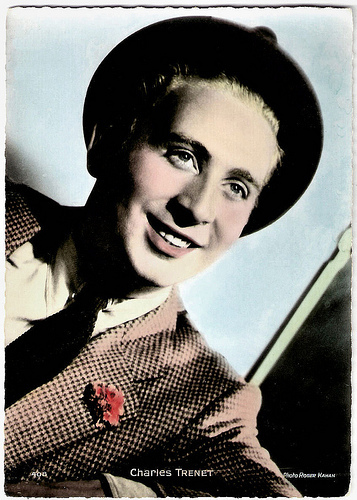
French postcard, no. 408. Photo: Roger Kahan.
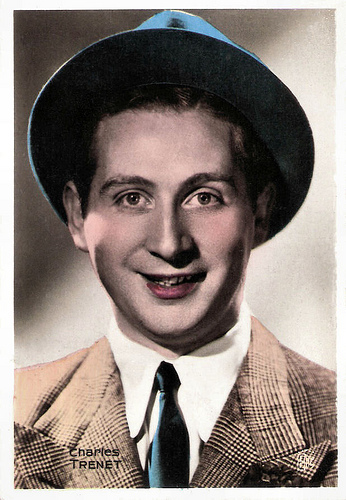
French mini-card by EPC.
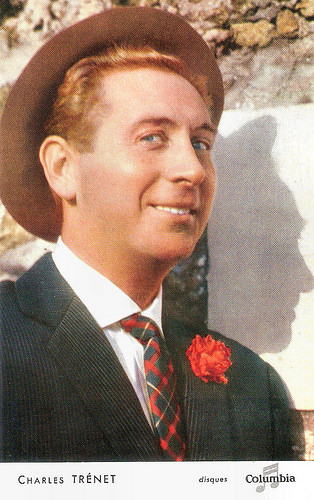
French postcard by JPB. Photo: disques Columbia.
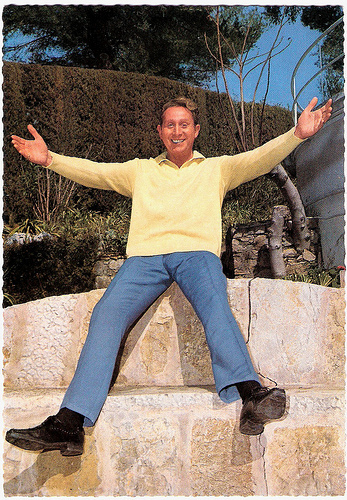
French postcard by PSG, no. 1261. Photo: Barclay.
The Singing Madman
Louis Charles Auguste Claude Trenet was born in Narbonne, France, in 1913. When he was seven years old, his parents divorced and he was sent to boarding school in Béziers, but he returned home just a few months later, suffering from typhoid fever.
It was during his convalescence at home that he developed his artistic talents, taking up music, painting and sculpting. After leaving school he left for Berlin where he studied art, and later, he also briefly studied at art schools in France. When Trenet first arrived in Paris in the 1930s, he worked in a film studio as a props handler and assistant, and later joined up with the artists in the Montparnasse neighborhood.
His admiration of the surrealist poet and Catholic mystic Max Jacob and his love of jazz were two factors that influenced Trenet's songs. From 1933 to 1936, he worked with the Swiss pianist Johnny Hess as a duo known as Charles and Johnny. They performed at various Parisian venues, and recorded 18 discs for Pathé. Around 1935, they appeared regularly on the radio. The duo continued until 1936 when Trenet was called up for national service.
It was after his national service that he received the nickname that he would retain all his life: Le fou chantant (the singing madman). In 1937, Trenet began his solo career, recording for Columbia, his first disc being Je chante/Fleur bleue (I Sing/Blue Flower). The exuberant Je chante gave rise to the notion of Trenet as a "singing vagabond", a theme that appeared in a number of his early songs and films.
His first film appearance was in the lead of the musical comedy Je chante/I Sing (Christian Stengel, 1938). At IMDb , DB du Monteil writes: “The song (Je chante: I sing) provides the movie with its title. The plot is one of the silliest you can think of. It's actually so silly it becomes almost enjoyable. The song is still popular in France whereas the movie is forgotten.” That same year he also starred in another musical comedy, La route enchantée/The Enchanted Road (Pierre Caron, 1938), in which he sang his celebrated song Quand Notre Coeur Fait Boum (When Our Heart Does Boom).
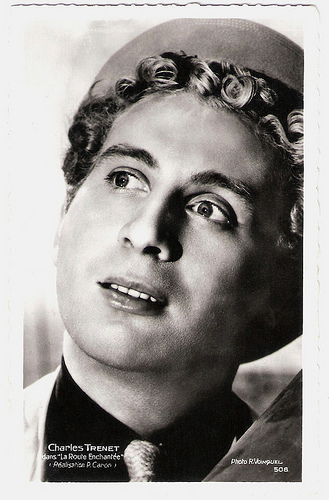
French postcard by Edit. Chantal, Rueil, no. 508. Photo: P. Voinquel. Publicity still for La route enchantée/The enchanted road (Pierre Caron, 1938).
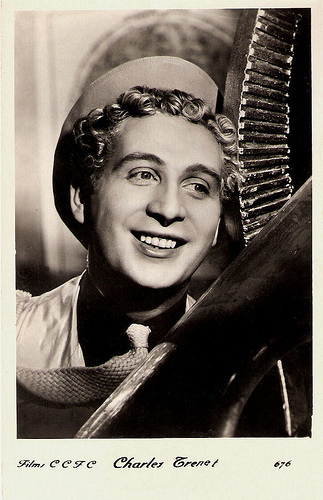
French postcard, no. 676. Photo: Films CCFC.
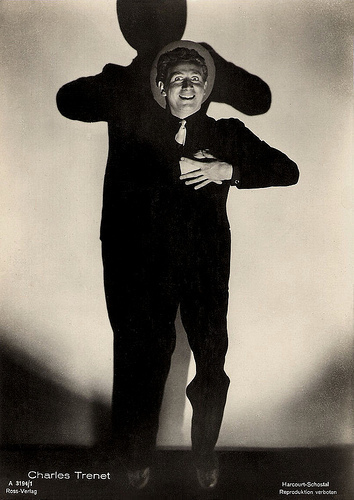
German postcard by Ross-Verlag, no. A 3194, 1941-1944. Photo: Harcourt / Schostal.
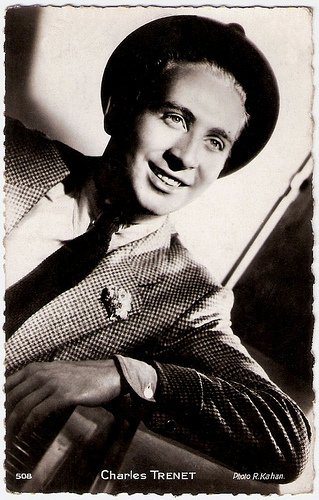
French postcard by Editions Chantal, Rueil, no. 508. Photo: R. Kahan.
Allied Code to the French ‘Underground’
At the start of World War II, Charles Trenet was mobilized. He was in barracks at Salon-de-Provence until he was demobilized in June 1940, when he moved back to Paris. There he would perform at the two famous cabarets Folies Bergère and at Gaîté Parisienne in front of a public often consisting of German officers and soldiers.
The collaborationist press tried to compromise his name and published that Trenet was the anagram of ‘Netter’ — a Jewish name. He was able to show his family tree to the authorities, proving that he had no Jewish origin. This act of self-defence was held against him long after the end of the war. Wikipedia explains that “like many other artists of the time, he chose to go on entertaining the occupying forces rather than sacrifice his career, showing little interest in the Jewish issue. He agreed, when asked by the Germans, to go and sing for the French prisoners in Germany. It is only fair to note that, as a homosexual, Trenet was himself in grave danger of deportation to the camps and may have had little choice but to co-operate and keep a low profile”.
Trenet continued to star in films like La romance de Paris/The Romance of Paris (Jean Boyer, 1941) with Yvette Lebon , Frédérica/Frederica (Jean Boyer, 1942) featuring Elvire Popesco , and Adieu Léonard (Pierre Prévert, 1943) starring Trenet as a village idiot. DB du Monteil calls it at IMDb “Charles Trénet's best film performance, by far.”
He co-starred with famous comedian Fernandel in La cavalcade des heures/Love Around the Clock (Yvan Noé, 1943). The refrain from the song Verlaine, "Blessent mon coeur d'une langueur monotone...", (Wound my heart with monotonous languor...) from Paul Verlaine's Song of Autumn, (popularized by Trenet) was used as the Allied code to the French ‘underground’ signaling that the Normandy invasion in June 1944 was imminent.
While many of his songs mined relatively conventional topics such as love, Paris, and nostalgia for his younger days, what set Trenet's songs apart were their personal, poetic, sometimes quite eccentric qualities, often infused with a warm wit. Some of his songs had unconventional subject matter, with whimsical imagery bordering on the surreal. Y'a d'la joie evokes 'joy' through a series of disconnected (though all vaguely phallic) images, including that of a subway car shooting out of its tunnel into the air, the Eiffel Tower crossing the street and a baker making excellent bread. Many of his hits from the 1930s and 1940s effectively combine the melodic and verbal nuances of French song with American swing rhythms.
His song La Mer, which according to legend he composed with Léo Chauliac on a train in 1943, was recorded in 1946. La Mer is perhaps his best known work outside the French-speaking world, with over 400 recorded versions. The song was given unrelated English words and under the title Beyond the Sea (or sometimes Sailing), was a hit for Bobby Darin in the early 1960s, and George Benson in the mid-1980s. La Mer has been used in many films such as The Dreamers (Bernardo Bertolucci, 2003), Mr. Bean's Holiday (Steve Bendelack, 2007) and in the opening credits of Le scaphandre et le papillon/The Diving Bell and the Butterfly (Julian Schnabel, 2007).
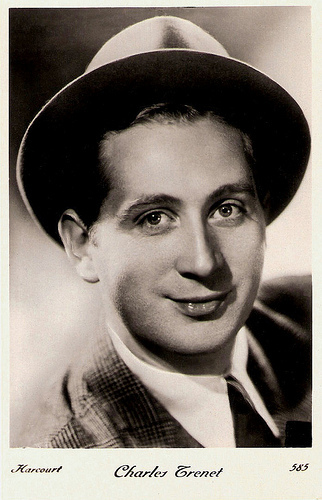
French postcard, no. 585. Photo: Harcourt.
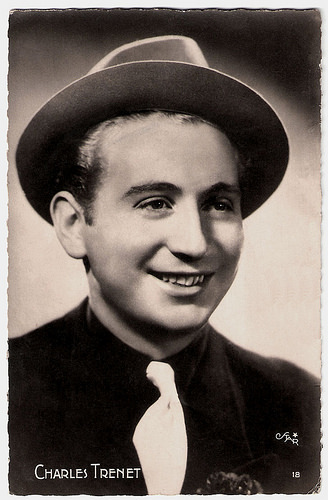
French postcard by O.P., Paris, no. 18. Photo: Star.
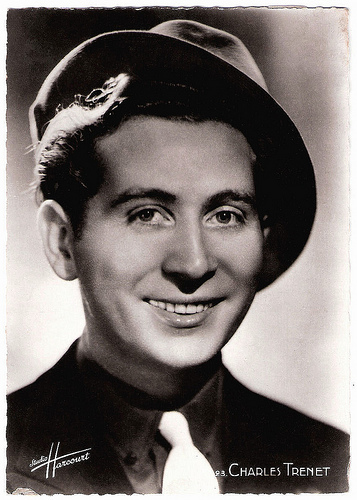
French postcard by Serp, Paris, no. 23. Photo: Studio Harcourt.
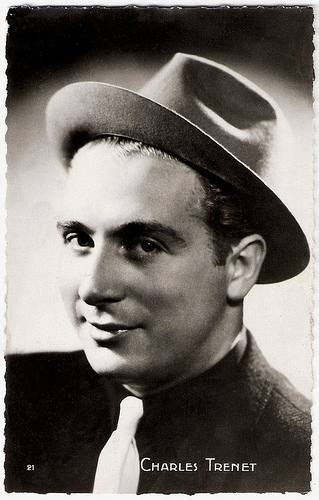
French postcard, no. 21, offered by Vénus, Menin.
28 Days in Prison
After the war Charles Trenet decided to move to the United States where he lived for a few years and where he quickly became a success. After a few triumphant concerts at the Bagdad in New York, Trenet became a big hit and was approached by Hollywood. He met the likes of Louis Armstrong and began a long-lasting friendship with Charlie Chaplin .
In 1951, Trenet returned to Paris and made a comeback at the Théâtre de l'Etoile. In Italy he did a musical appearance in the film Giovinezza/Youth (Giorgio Pastina, 1952) with Delia Scala and Franco Interlenghi. His songs also featured in such international films as Dead of Night (Alberto Cavalcanti a.o., 1945), the Cary Grant comedy Every Girl Should Be Married (Don Hartman, 1948), and Love in the Afternoon (Billy Wilder, 1957) starring Audrey Hepburn and Gary Cooper.
In 1954 Trenet performed at the Olympia music-hall in Paris for the first time. In 1960 he returned to the Théâtre de l'Etoile, appearing on stage for the very first time without the famous trilby hat which had for so long been part of his act.
In 1963, Trenet spent 28 days in prison in Aix-en-Provence. He was charged with corrupting the morals of four young men under the age of 21 (they were 19). His chauffeur claimed that Trenet was using him as a pimp. The charges were eventually dropped, but the affair brought to public light the fact that Trenet was homosexual. He was never particularly public about it and spoke of it rarely.
In his authorized biography of Maurice Chevalier , author David Brett claims that Chevalier and Mistinguett were the ones who first ‘shopped’ Trenet to the police for consorting with underage boys, around 1940. Trenet never learned of their action.
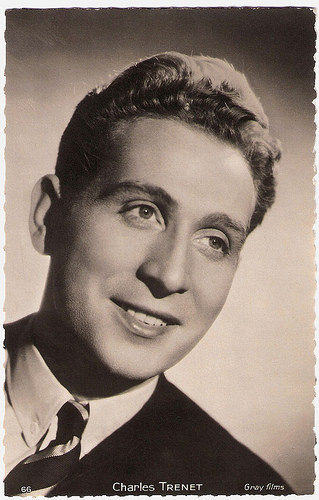
French postcard by E. C., Paris, no. 66. Photo: Gray films. Publicity still for Frédérica (Jean Boyer, 1942).
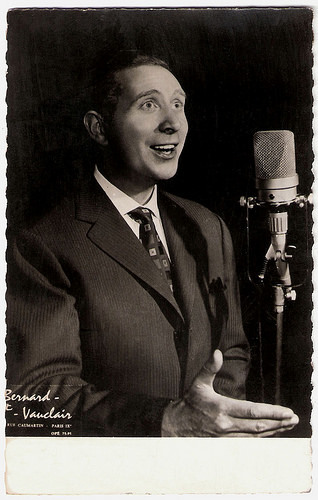
French postcard by Editions P.I., Paris, no. 865. Photo: Bernard Vauclair, Paris.
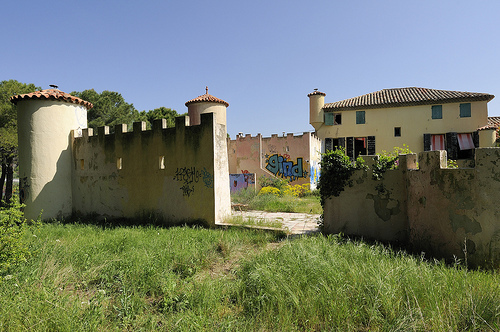
Charles Trenet's mansion nowadays. Le domaine des Esprits, Aix-en-Provence, France. Photo: Didier@Flickr.
Emotional Farewell
In 1970, Charles Trenet flew to Japan to represent France at the Universal Exhibition in Osaka. The following year he left Columbia, his long-time record label, and recorded Fidèle and Il y avait des arbres. He also made a memorable appearance at the Olympia.
In 1973, Trenet, who had just celebrated his 60th birthday, recorded a new album, Chansons en liberté. The twelve songs on this album were an interesting mix of old and new compositions. His 60th birthday was celebrated in grand style by the French media. Trenet made a surprise announcement in 1975, declaring that he was retiring from the music world. At the end of his final concert at the Olympia he bade his audience an emotional farewell.
Following the death of his mother in 1979, he shut himself away from the world for the next two years. Nevertheless, in 1981 he made a comeback with a new album, devoted to sentimental memories of his childhood. Trenet then returned to his peaceful semi-retirement in the South of France, occasionally rousing himself to give a special gala performance in France or abroad. After giving farewell concerts in France, Trenet was persuaded out of retirement again in 1983 for a farewell concert in Montreal. As a result Trenet performed many more concerts including a series every night for three weeks at the Palais des congrès in Paris in 1986.
In 1999, he returned to the forefront of the music scene with a brand new album entitled Les poètes descendent dans la rue (Poets Take to the Streets). Nearly sixty years after writing his legendary classic La mer, Trenet proved that he was capable of coming up with fourteen inspired new tracks. Following the success of the album, Trenet returned to the live circuit. His concerts proved a huge success, fans in the audience breaking into rapturous applause.
In 2000 old age began to catch up with Trenet, however, and he was rushed to hospital after suffering a stroke. The singer was forced to spend several weeks in hospital recovering, but by the autumn of that year he was well enough to attend the dress rehearsal of Charles Aznavour 's show at the Palais des Congrès.
However, this was his final public appearance. In November 2000 the Narbonne house in which Trenet was born — which had become 13 Avenue Charles Trenet — was turned into a tiny museum. Visitors were able to view souvenirs from Trenet's childhood and family life, as well as original drafts of the songs which had made his career. Charles Trenet passed away in 2001, in Créteil, France.
Charles Trenet sings Boum in the film La route enchantée/The Enchanted Road (1938). Source: Charles Trenet (YouTube).
Charles Trenet listens to a record of Que reste-t-il de nos amours? in the film La cavalcade des heures/Love Around the Clock (1943). Source: Charles Trenet (YouTube).
Charles Trenet sings Le debit de lait in the film La cavalcade des heures/Love Around the Clock (1943). Source: Charles Trenet (YouTube).
Charles Trénet sings La Mer live at the Olympia. Source: Charles Trenet (YouTube).
Sources: DB du Monteil (IMDb), Wikipedia and .

French postcard, no. 408. Photo: Roger Kahan.

French mini-card by EPC.

French postcard by JPB. Photo: disques Columbia.

French postcard by PSG, no. 1261. Photo: Barclay.
The Singing Madman
Louis Charles Auguste Claude Trenet was born in Narbonne, France, in 1913. When he was seven years old, his parents divorced and he was sent to boarding school in Béziers, but he returned home just a few months later, suffering from typhoid fever.
It was during his convalescence at home that he developed his artistic talents, taking up music, painting and sculpting. After leaving school he left for Berlin where he studied art, and later, he also briefly studied at art schools in France. When Trenet first arrived in Paris in the 1930s, he worked in a film studio as a props handler and assistant, and later joined up with the artists in the Montparnasse neighborhood.
His admiration of the surrealist poet and Catholic mystic Max Jacob and his love of jazz were two factors that influenced Trenet's songs. From 1933 to 1936, he worked with the Swiss pianist Johnny Hess as a duo known as Charles and Johnny. They performed at various Parisian venues, and recorded 18 discs for Pathé. Around 1935, they appeared regularly on the radio. The duo continued until 1936 when Trenet was called up for national service.
It was after his national service that he received the nickname that he would retain all his life: Le fou chantant (the singing madman). In 1937, Trenet began his solo career, recording for Columbia, his first disc being Je chante/Fleur bleue (I Sing/Blue Flower). The exuberant Je chante gave rise to the notion of Trenet as a "singing vagabond", a theme that appeared in a number of his early songs and films.
His first film appearance was in the lead of the musical comedy Je chante/I Sing (Christian Stengel, 1938). At IMDb , DB du Monteil writes: “The song (Je chante: I sing) provides the movie with its title. The plot is one of the silliest you can think of. It's actually so silly it becomes almost enjoyable. The song is still popular in France whereas the movie is forgotten.” That same year he also starred in another musical comedy, La route enchantée/The Enchanted Road (Pierre Caron, 1938), in which he sang his celebrated song Quand Notre Coeur Fait Boum (When Our Heart Does Boom).

French postcard by Edit. Chantal, Rueil, no. 508. Photo: P. Voinquel. Publicity still for La route enchantée/The enchanted road (Pierre Caron, 1938).

French postcard, no. 676. Photo: Films CCFC.

German postcard by Ross-Verlag, no. A 3194, 1941-1944. Photo: Harcourt / Schostal.

French postcard by Editions Chantal, Rueil, no. 508. Photo: R. Kahan.
Allied Code to the French ‘Underground’
At the start of World War II, Charles Trenet was mobilized. He was in barracks at Salon-de-Provence until he was demobilized in June 1940, when he moved back to Paris. There he would perform at the two famous cabarets Folies Bergère and at Gaîté Parisienne in front of a public often consisting of German officers and soldiers.
The collaborationist press tried to compromise his name and published that Trenet was the anagram of ‘Netter’ — a Jewish name. He was able to show his family tree to the authorities, proving that he had no Jewish origin. This act of self-defence was held against him long after the end of the war. Wikipedia explains that “like many other artists of the time, he chose to go on entertaining the occupying forces rather than sacrifice his career, showing little interest in the Jewish issue. He agreed, when asked by the Germans, to go and sing for the French prisoners in Germany. It is only fair to note that, as a homosexual, Trenet was himself in grave danger of deportation to the camps and may have had little choice but to co-operate and keep a low profile”.
Trenet continued to star in films like La romance de Paris/The Romance of Paris (Jean Boyer, 1941) with Yvette Lebon , Frédérica/Frederica (Jean Boyer, 1942) featuring Elvire Popesco , and Adieu Léonard (Pierre Prévert, 1943) starring Trenet as a village idiot. DB du Monteil calls it at IMDb “Charles Trénet's best film performance, by far.”
He co-starred with famous comedian Fernandel in La cavalcade des heures/Love Around the Clock (Yvan Noé, 1943). The refrain from the song Verlaine, "Blessent mon coeur d'une langueur monotone...", (Wound my heart with monotonous languor...) from Paul Verlaine's Song of Autumn, (popularized by Trenet) was used as the Allied code to the French ‘underground’ signaling that the Normandy invasion in June 1944 was imminent.
While many of his songs mined relatively conventional topics such as love, Paris, and nostalgia for his younger days, what set Trenet's songs apart were their personal, poetic, sometimes quite eccentric qualities, often infused with a warm wit. Some of his songs had unconventional subject matter, with whimsical imagery bordering on the surreal. Y'a d'la joie evokes 'joy' through a series of disconnected (though all vaguely phallic) images, including that of a subway car shooting out of its tunnel into the air, the Eiffel Tower crossing the street and a baker making excellent bread. Many of his hits from the 1930s and 1940s effectively combine the melodic and verbal nuances of French song with American swing rhythms.
His song La Mer, which according to legend he composed with Léo Chauliac on a train in 1943, was recorded in 1946. La Mer is perhaps his best known work outside the French-speaking world, with over 400 recorded versions. The song was given unrelated English words and under the title Beyond the Sea (or sometimes Sailing), was a hit for Bobby Darin in the early 1960s, and George Benson in the mid-1980s. La Mer has been used in many films such as The Dreamers (Bernardo Bertolucci, 2003), Mr. Bean's Holiday (Steve Bendelack, 2007) and in the opening credits of Le scaphandre et le papillon/The Diving Bell and the Butterfly (Julian Schnabel, 2007).

French postcard, no. 585. Photo: Harcourt.

French postcard by O.P., Paris, no. 18. Photo: Star.

French postcard by Serp, Paris, no. 23. Photo: Studio Harcourt.

French postcard, no. 21, offered by Vénus, Menin.
28 Days in Prison
After the war Charles Trenet decided to move to the United States where he lived for a few years and where he quickly became a success. After a few triumphant concerts at the Bagdad in New York, Trenet became a big hit and was approached by Hollywood. He met the likes of Louis Armstrong and began a long-lasting friendship with Charlie Chaplin .
In 1951, Trenet returned to Paris and made a comeback at the Théâtre de l'Etoile. In Italy he did a musical appearance in the film Giovinezza/Youth (Giorgio Pastina, 1952) with Delia Scala and Franco Interlenghi. His songs also featured in such international films as Dead of Night (Alberto Cavalcanti a.o., 1945), the Cary Grant comedy Every Girl Should Be Married (Don Hartman, 1948), and Love in the Afternoon (Billy Wilder, 1957) starring Audrey Hepburn and Gary Cooper.
In 1954 Trenet performed at the Olympia music-hall in Paris for the first time. In 1960 he returned to the Théâtre de l'Etoile, appearing on stage for the very first time without the famous trilby hat which had for so long been part of his act.
In 1963, Trenet spent 28 days in prison in Aix-en-Provence. He was charged with corrupting the morals of four young men under the age of 21 (they were 19). His chauffeur claimed that Trenet was using him as a pimp. The charges were eventually dropped, but the affair brought to public light the fact that Trenet was homosexual. He was never particularly public about it and spoke of it rarely.
In his authorized biography of Maurice Chevalier , author David Brett claims that Chevalier and Mistinguett were the ones who first ‘shopped’ Trenet to the police for consorting with underage boys, around 1940. Trenet never learned of their action.

French postcard by E. C., Paris, no. 66. Photo: Gray films. Publicity still for Frédérica (Jean Boyer, 1942).

French postcard by Editions P.I., Paris, no. 865. Photo: Bernard Vauclair, Paris.

Charles Trenet's mansion nowadays. Le domaine des Esprits, Aix-en-Provence, France. Photo: Didier@Flickr.
Emotional Farewell
In 1970, Charles Trenet flew to Japan to represent France at the Universal Exhibition in Osaka. The following year he left Columbia, his long-time record label, and recorded Fidèle and Il y avait des arbres. He also made a memorable appearance at the Olympia.
In 1973, Trenet, who had just celebrated his 60th birthday, recorded a new album, Chansons en liberté. The twelve songs on this album were an interesting mix of old and new compositions. His 60th birthday was celebrated in grand style by the French media. Trenet made a surprise announcement in 1975, declaring that he was retiring from the music world. At the end of his final concert at the Olympia he bade his audience an emotional farewell.
Following the death of his mother in 1979, he shut himself away from the world for the next two years. Nevertheless, in 1981 he made a comeback with a new album, devoted to sentimental memories of his childhood. Trenet then returned to his peaceful semi-retirement in the South of France, occasionally rousing himself to give a special gala performance in France or abroad. After giving farewell concerts in France, Trenet was persuaded out of retirement again in 1983 for a farewell concert in Montreal. As a result Trenet performed many more concerts including a series every night for three weeks at the Palais des congrès in Paris in 1986.
In 1999, he returned to the forefront of the music scene with a brand new album entitled Les poètes descendent dans la rue (Poets Take to the Streets). Nearly sixty years after writing his legendary classic La mer, Trenet proved that he was capable of coming up with fourteen inspired new tracks. Following the success of the album, Trenet returned to the live circuit. His concerts proved a huge success, fans in the audience breaking into rapturous applause.
In 2000 old age began to catch up with Trenet, however, and he was rushed to hospital after suffering a stroke. The singer was forced to spend several weeks in hospital recovering, but by the autumn of that year he was well enough to attend the dress rehearsal of Charles Aznavour 's show at the Palais des Congrès.
However, this was his final public appearance. In November 2000 the Narbonne house in which Trenet was born — which had become 13 Avenue Charles Trenet — was turned into a tiny museum. Visitors were able to view souvenirs from Trenet's childhood and family life, as well as original drafts of the songs which had made his career. Charles Trenet passed away in 2001, in Créteil, France.
Charles Trenet sings Boum in the film La route enchantée/The Enchanted Road (1938). Source: Charles Trenet (YouTube).
Charles Trenet listens to a record of Que reste-t-il de nos amours? in the film La cavalcade des heures/Love Around the Clock (1943). Source: Charles Trenet (YouTube).
Charles Trenet sings Le debit de lait in the film La cavalcade des heures/Love Around the Clock (1943). Source: Charles Trenet (YouTube).
Charles Trénet sings La Mer live at the Olympia. Source: Charles Trenet (YouTube).
Sources: DB du Monteil (IMDb), Wikipedia and .
Published on September 16, 2015 22:00
Paul van Yperen's Blog
- Paul van Yperen's profile
- 13 followers
Paul van Yperen isn't a Goodreads Author
(yet),
but they
do have a blog,
so here are some recent posts imported from
their feed.



